Featured Topics
Featured series.
A series of random questions answered by Harvard experts.

Explore the Gazette
Read the latest.

Why Democrats, Republicans, who appear at war these days, really need each other

Decline of golden age for American Jews

Election theft 101: Foster skepticism
Do phones belong in schools.
iStock by Getty Images
Harvard Staff Writer
Bans may help protect classroom focus, but districts need to stay mindful of students’ sense of connection, experts say
Students around the world are being separated from their phones.
In 2020, the National Center for Education Statistics reported that 77 percent of U.S. schools had moved to prohibit cellphones for nonacademic purposes. In September 2018, French lawmakers outlawed cellphone use for schoolchildren under the age of 15. In China, phones were banned country-wide for schoolchildren last year.
Supporters of these initiatives have cited links between smartphone use and bullying and social isolation and the need to keep students focused on schoolwork.
77% Of U.S. schools moved to ban cellphones for nonacademic purposes as of 2020, according to the National Center for Education Statistics
But some Harvard experts say instructors and administrators should consider learning how to teach with tech instead of against it, in part because so many students are still coping with academic and social disruptions caused by the pandemic. At home, many young people were free to choose how and when to use their phones during learning hours. Now, they face a school environment seeking to take away their main source of connection.
“Returning back to in-person, I think it was hard to break the habit,” said Victor Pereira, a lecturer on education and co-chair of the Teaching and Teaching Leadership Program at the Graduate School of Education.
Through their students, he and others with experience both in the classroom and in clinical settings have seen interactions with technology blossom into important social connections that defy a one-size-fits-all mindset. “Schools have been coming back, trying to figure out, how do we readjust our expectations?” Pereira added.
It’s a hard question, especially in the face of research suggesting that the mere presence of a smartphone can undercut learning .
Michael Rich , an associate professor of pediatrics at Harvard Medical School and an associate professor of social and behavioral sciences at the Harvard T.H. Chan School of Public Health, says that phones and school don’t mix: Students can’t meaningfully absorb information while also texting, scrolling, or watching YouTube videos.
“The human brain is incapable of thinking more than one thing at a time,” he said. “And so what we think of as multitasking is actually rapid-switch-tasking. And the problem with that is that switch-tasking may cover a lot of ground in terms of different subjects, but it doesn’t go deeply into any of them.”
Pereira’s approach is to step back — and to ask whether a student who can’t resist the phone is a signal that the teacher needs to work harder on making a connection. “Two things I try to share with my new teachers are, one, why is that student on the phone? What’s triggering getting on your cell phone versus jumping into our class discussion, or whatever it may be? And then that leads to the second part, which is essentially classroom management.
“Design better learning activities, design learning activities where you consider how all of your students might want to engage and what their interests are,” he said. He added that allowing phones to be accessible can enrich lessons and provide opportunities to use technology for school-related purposes.
Mesfin Awoke Bekalu, a research scientist in the Lee Kum Sheung Center for Health and Happiness at the Chan School, argues that more flexible classroom policies can create opportunities for teaching tech-literacy and self-regulation.
“There is a huge, growing body of literature showing that social media platforms are particularly helpful for people who need resources or who need support of some kind, beyond their proximate environment,” he said. A study he co-authored by Rachel McCloud and Vish Viswanath for the Lee Kum Sheung Center for Health and Happiness shows that this is especially true for marginalized groups such as students of color and LGBTQ students. But the findings do not support a free-rein policy, Bekalu stressed.
In the end, Rich, who noted the particular challenges faced by his patients with attention-deficit disorders and other neurological conditions, favors a classroom-by-classroom strategy. “It can be managed in a very local way,” he said, adding: “It’s important for parents, teachers, and the kids to remember what they are doing at any point in time and focus on that. It’s really only in mono-tasking that we do very well at things.”
Share this article
You might like.
Political philosopher Harvey C. Mansfield says it all goes back to Aristotle, balance of competing ideas about common good

Franklin Foer recounts receding antisemitism of past 100 years, recent signs of resurgence of hate, historical pattern of scapegoating

Two legal scholars, stunned by Jan. 6 insurrection, game out half-dozen possible schemes that exploit, spotlight flaws in system
Aspirin cuts liver fat in trial
10 percent reduction seen in small study of disease that affects up to a third of U.S. adults
Pushing back on DEI ‘orthodoxy’
Panelists support diversity efforts but worry that current model is too narrow, denying institutions the benefit of other voices, ideas
So what exactly makes Taylor Swift so great?
Experts weigh in on pop superstar's cultural and financial impact as her tours and albums continue to break records.

Home » Tips for Teachers » Why Cell Phones Should Be Allowed in Schools — 11 Reasons Based on 16 Research Studies
Why Cell Phones Should Be Allowed in Schools — 11 Reasons Based on 16 Research Studies
The dramatic rise in cell phone usage globally , including among younger, school-aged users , brings into focus the debate on why phones should be allowed in school.
Cell phones are a forbidden item in most classrooms. Many schools have policies against students taking their gadgets out of their backpacks during the day or even bringing them to school at all.

However, I think that cell phones can play a very beneficial role in a classroom, especially when used effectively. I’ve stretched the ‘rules’ in the past and let my students pull out their phones for various classroom lessons and activities, and I’m definitely glad I did!
Some also believe that allowing students to use phones in school teaches them responsible usage for later in life:
If we don’t let kids use cell phones in the classroom, how will they ever learn to use them responsibly in a workplace? Every adult I know uses their phone all day every day. Let’s prepare kids for the real world. — Matthew B. Courtney, Ed.D. (@mbcourtneyedd) August 7, 2022
In addition to keeping my students more engaged in learning, using the gadgets offered a whole host of other benefits, many of which I didn’t even think of until I saw them! I’d love to share my answers to the question “why should students be allowed to use cell phones in class” with you.
In this article, I’ll share:
Cell Phones in School — Teachers’ Thoughts
- Why Should Phones be Allowed in School
7 Ideas How Cell Phones Can Be Used Effectively in the Classroom
Digital etiquette for students in the classroom.
You can watch this video below. It contains a brief retelling of the article.
Many teachers and parents are on the fence about whether to let students have cell phones in school . More and more teachers are beginning to see the potential learning benefits mobile phones can offer to their students and are advocating for gadget use in the classroom. In this video, Sam from New EdTech Classroom Why we should allow students to use cell phones in schools.
Below are what some teachers have shared about using mobile phones in the classroom:
”We need to embrace these changes and instead of trying to separate that reality from an outdated vision of a classroom, we need to find a way to optimize the educational experience for the connected kids of the future. We can’t disconnect them from the world between the hours of 8am – 3pm everyday. Don’t be scared. You have to leave your comfort zone and take a risk. The same thing you ask your students to do. Take a risk and see what the future may look like and then change your teaching to ensure that the technology is used as a tool and not just a distraction.” —Tim Floyd, Education Awesomeness
“I’ve also seen the value that cell phones can bring to education. Students who might not have access to computers at home can type and submit essays on their phones. Students can quickly look up some information and verify its validity. Furthermore, students can also use their cell phones to collaborate with their peers.” —Christina, The Darling English Teacher
“When students have access to technology and social media, they have access to empowerment and leadership online. As educators, we need to empower our students to use technology for good. When students are given the chance to use their cellphones in class as a learning tool, we can teach them how to positively influence and impact other people online.” —Amanda, EDTech Endeavors
“When students have access to technology and social media, they have access to empowerment and leadership online. As educators, we need to empower our students to use technology for good. When students are given the chance to use their cellphones in class as a learning tool, we can teach them how to positively influence and impact other people online.” — A.J. Juliani , the Director of Technology & Innovation for Centennial School District
Why Should Phones be Allowed in School — 11 Reasons
There is a lot of debate about whether phones should be allowed in schools. While there are some cons to letting your students use cell phones in class, I feel that the benefits of using gadgets can outweigh these cons. As long as you have solid classroom management and set clear expectations for students using their mobile phones, I think you’ll find that there are many benefits to letting your students use them.

Setting up a phone charging station, just as you may set up a tablet or Chromebook charging station in your classroom, can ensure your students’ gadgets are charged and ready when needed during instruction.
Many people wonder, “why should students be allowed to use cell phones in class?” In my opinion, some of the biggest benefits of allowing students to use their phones in school include:
1. Providing an Additional Tool for Learning

In today’s digital age, the ubiquity of mobile phones, especially among younger individuals, is undeniable. Most children receive their first phone around the age of 11-12 , making these devices a prevalent part of their daily lives even before they hit their teenage years. The integration of these phones in the classroom, thus, presents a unique opportunity for enhancing the learning experience.
When students have the freedom to use their mobile phones during lessons, they instantly gain a portal to a world of technology right at their fingertips. This is invaluable, particularly in educational settings where there might be a shortage of tablets or computers. Instead of waiting for their turn on limited school devices, students can directly tap into the vast reservoir of information available online via their phones. Here are some of the benefits:
- Powerful Research Tools: Mobile phones can be transformative tools for research. If a student encounters a concept they’re unfamiliar with or if a topic sparks their curiosity, they can swiftly dive into a deeper exploration online.
- Interactive Learning: Educators can capitalize on interactive elements by using phones for classroom polls, ensuring active engagement and participation from all students. It becomes an immediate feedback mechanism, gauging understanding and promoting discussions.
- Note-Taking and Collaboration: With the myriad of note-taking and word-processing apps available, students can seamlessly jot down their thoughts, answers, or even craft detailed essays. This not only promotes paperless classrooms but also allows for easy sharing and collaboration among peers.
In essence, by harnessing the potential of mobile phones, educators can cultivate dynamic, interactive, and resource-rich environments that cater to the needs of the modern student.

In the context of safety and the unpredictable nature of emergencies, the presence of cell phones with students becomes of paramount importance. Particularly, in the gravest and unfortunately increasingly prevalent scenarios like school shootings , a mobile phone can serve as a lifeline. During such incidents, when every second is crucial, students can use their phones to alert authorities, inform their parents about their safety, or even receive vital instructions from law enforcement.
Phones are already banned. The parents are worried about these bans because of the very high chance there is a school shooting and their child is unable to call for help. https://t.co/TxpJfrUgJn — Anosognosiogenesis (@pookleblinky) June 6, 2023
Schools, as places of learning, also bear the responsibility of ensuring the well-being of their students. Cell phones can be crucial in the subsequent scenarios:
- Unpredictable Events: In the unfortunate event of an unforeseen incident or crisis at school, having immediate access to a cell phone can make a significant difference. One of the primary advantages is the ability to swiftly contact parents or guardians. Whether it’s to inform them about an unexpected situation or to seek urgent assistance, being able to communicate directly can offer both the student and parent a measure of relief in stressful situations.
- Commuting Students: For students who commute alone or those who remain on school premises for extracurricular activities, a mobile phone serves as an essential tool to stay connected.
- Medical Emergencies: In situations where there might be a need for medical attention or other emergency services, the quick dialing capability of a phone can be life-saving. Without it, students may find themselves isolated and without the immediate resources to seek help.
While detractors may argue against the distractions phones might pose academically, the security and peace of mind they offer, especially in dire situations, make a compelling case for their presence in the school environment.
3. Improved Communication
In our rapidly evolving digital age, the line of communication between students and their educators is becoming increasingly streamlined thanks to the ubiquitous use of cell phones. Apart from maintaining connections with family and friends, students are harnessing the power of these devices to facilitate a more direct and immediate line of dialogue with their teachers. This virtual bridge enables students to:
- Promptly relay their feedback to the teachers
- Pose queries for immediate resolution
- Engage in constructive discussions, irrespective of the confines of school hours
Even when teachers find themselves swamped during the day, mobile communication ensures that students aren’t left hanging. Queries sent after school hours can be addressed at the teacher’s earliest convenience, eliminating the conventional wait time that could span till the next school day. The immediacy of this system enhances the overall learning experience.
Interestingly, a study from the School of Business highlighted another crucial dimension to this trend. Beyond the teacher-student dynamic, students are proactively forming educational bonds with their peers through their phones. They often initiate and manage class-based groups on various social platforms, allowing for an organized exchange of study materials and collaborative learning, devoid of any official oversight. Such initiatives underscore the instrumental role cell phones play in modern education, fostering a holistic and communal approach to learning.
4. Organization

In today’s digitally-driven world, cell phones have evolved beyond mere communication devices. They now function as personal assistants, packed with tools designed to enhance productivity and organization. For students, these devices can play a pivotal role in shaping their academic journey, thanks to an array of built-in features such as calendar apps, clocks, alarms, and reminders.
Here are the key features that can be beneficial for students:
- Calendar App: It can be an invaluable tool for students to plot out their academic calendar, inputting assignment due dates, exam schedules, and even extracurricular commitments. With reminders set up, students receive timely prompts, ensuring that no task is forgotten or left to the last minute.
- Alarms: They can be utilized not just to wake up for school but also to ensure punctuality for classes or study group meetings.
- Clock: This feature can assist in time management, allowing students to allocate specific blocks of time for focused study, breaks, or recreational activities.
By planning and visualizing their day or week, students can achieve a balance between academic and personal commitments. This underlines why phones should be allowed in school, as cell phones, often perceived as distractions, can actually be powerful organizational tools. When used wisely, they can significantly enhance a student’s ability to manage time, keep up with responsibilities, and maintain a balanced academic life.
5. Can Save Schools Money
The digital revolution has fundamentally transformed the education sector, offering avenues for cost-saving and enhanced accessibility.
Here’s how schools can leverage cell phones for economical and sustainable education:
- E-books and Online Materials: A significant advantage is the rise of e-books and online course materials. By allowing students to access these digital resources via their cell phones, schools stand to benefit economically and environmentally. When students use their phones to tap into a plethora of e-books and other online resources, it significantly reduces the need for schools to invest in physical textbooks, which can be expensive to purchase, update, and maintain. This shift to digital not only alleviates financial pressures but also ensures that students have the most up-to-date information right at their fingertips.
- Digital Document Sharing: Moreover, the digital sharing of documents by teachers further complements this eco-friendly and economical approach. Instead of relying on traditional methods of printing and copying, which come with associated costs and environmental concerns, educators can instantly distribute study materials, assignments, and other critical documents. This streamlined method reduces paper waste, aids in quicker dissemination of information, and fosters a more efficient classroom environment.
In conclusion, embracing the capabilities of cell phones in the academic realm presents a win-win scenario. It offers students the convenience and immediacy of digital access while allowing educational institutions to optimize resources, reduce costs, and promote sustainability.
6. Good for the Environment

The push towards a more sustainable and environmentally conscious approach in education is becoming increasingly important, and digital transformation plays a pivotal role in this shift. By reducing the reliance on print resources and leveraging digital platforms, educational institutions are not only achieving significant financial savings but also contributing positively to environmental conservation.
Using gadgets in classrooms leads to:
- Saving Paper: It’s worth noting that a typical school consumes approximately 75 trees per year , further exacerbating the issues of deforestation. Every sheet of paper spared from printing translates to saved trees, which play an indispensable role in absorbing carbon dioxide, regulating global temperatures, and fostering biodiversity. By reducing the demand for paper, schools indirectly promote forest conservation and reduce their carbon footprint.
- Reducing Ink and Energy Consumption: The cascading benefits extend beyond just paper conservation. Lesser printing implies reduced consumption of ink, which in turn means fewer plastic cartridges that often end up in landfills. The energy used by printers and copiers, though seemingly minor on a day-to-day basis, accumulates over time, leading to substantial power consumption. By cutting down on these activities, institutions also reduce their energy footprint and the associated greenhouse gas emissions.
In essence, embracing digital alternatives in education is not merely a cost-saving strategy; it’s a declaration of commitment to the planet. Schools and educators, by opting for this approach, are not only preparing students for a digital future but also instilling in them the values of sustainability and responsible consumption.
7. Prepares Students for the Future
As educators, our primary responsibility extends beyond just imparting knowledge; it involves equipping students with skills and tools that will remain relevant in their future endeavors.
Undeniably, in the rapidly evolving landscape of the 21st century, technology stands as a colossal pillar shaping numerous sectors. In such a milieu, it becomes imperative for students to not only be familiar with but also proficient in utilizing technological tools, including mobile phones. Here’s what students can acquire that will be advantageous for their future:
- Using Phones as Research Tools: Mobile phones, often perceived merely as communication tools, have metamorphosed into multifunctional devices capable of tasks ranging from basic research to complex problem-solving. By incorporating them into the classroom environment, we offer students a hands-on approach to understand and harness the vast potential these devices possess.
- Enhancing Education through App-Based Learning: Moreover, phones serve as a practical tool to teach students how to study using technology, introducing them to a plethora of educational apps and online resources that can enhance their learning experiences.
- Preparing for a Future Profession: Furthermore, as many future careers will demand technological adeptness, proficiency in using smartphones and other tech tools can be a significant advantage for students entering the workforce. They will inevitably encounter scenarios where quick thinking, complemented by technological skills, will be invaluable.
In conclusion, embracing mobile phones in educational settings is more than just keeping pace with the times; it’s a forward-looking strategy. By doing so, we not only enhance the current learning experience but also lay a robust foundation for our students, ensuring they are well-prepared and competitive in their future careers.
8. Can Create Digitally Responsible Citizens

In an age dominated by digital communication, it’s crucial to instill not only tech proficiency but also digital etiquette among students. Schools, as primary centers of learning and social interaction, have an essential role in shaping this aspect of students’ digital journey. By permitting gadget use within school premises, we lay the groundwork for creating digitally responsible citizens.
Understanding the nuances of when and where to use a phone is paramount . Here’s how educational institutions can guide students towards responsible digital citizenship:
- Learning Digital Etiquette: In a professional setting or during crucial personal interactions, the inappropriate use of a mobile device can be perceived as disrespectful or inattentive. For instance, looking up and maintaining eye contact when someone addresses you demonstrates respect and active engagement, an essential soft skill in both professional and personal realms.
- Providing Environment for Practice: The school environment offers a controlled and supervised platform where students can practice these etiquettes. They can learn to strike a balance between staying digitally connected and being physically present, discerning when to put away their devices and engage with their surroundings.
Without these lessons, students may inadvertently cultivate habits that may hinder their interpersonal relationships in the future. Thus, integrating digital etiquette into the curriculum doesn’t just foster tech-savvy individuals; it molds well-rounded, respectful citizens adept at navigating the digital and real-world landscapes.
9. Can Help Students When Studying
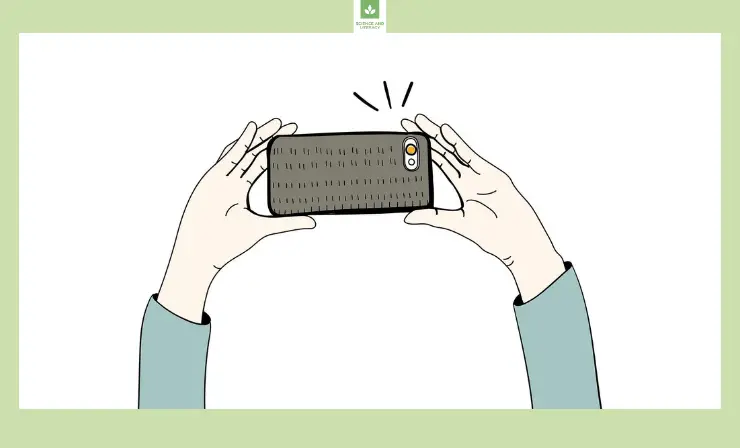
In today’s digital age, the traditional means of note-taking have undergone a transformative evolution, with smartphones emerging as invaluable tools in this process. The built-in camera on mobile phones offers students an efficient and immediate way to capture essential educational content, augmenting their learning experience. Here’s how this can be helpful:
- Capturing Visuals Efficiently: During lectures or instructional sessions, there are often intricate diagrams, charts, or images that may be time-consuming or challenging to replicate by hand in notebooks. Here, the mobile camera serves as a boon. With a quick snap, students can capture these visuals in high resolution, ensuring they don’t miss out on any crucial details. This method not only saves time but also guarantees the accuracy of the information they’re recording.
“In my classes, I let students take pictures of the digital whiteboard, too. If an assignment description or important PowerPoint slide has been up long enough and I am ready to move on, before doing so, I invite kids to snap a picture. This allows them to refer back to the slide at home if necessary.” — Chad Donohue , National Education Association
- Reviewing and Studying: When it’s time to review the material, be it for a quiz, exam, or class discussion, these photographic notes can be invaluable. Students can easily revisit these images, zooming in on specific details or annotating them with additional insights. This visual approach to studying aids in better retention of information and can make abstract or complex concepts more tangible and understandable.
In essence, the integration of mobile cameras into the educational process amplifies the efficiency of learning. By merging traditional note-taking with digital resources, students are equipped with a richer, more comprehensive set of study materials, paving the way for enhanced academic performance.
10. Accessibility and Personalized Learning
The rise of technology in the educational sector has ushered in a new era marked by accessibility and personalized learning, with cell phones being central to this revolution. The push to incorporate mobile phones in the classroom stems from the profound potential they hold in creating more inclusive and tailored educational experiences, for example:
- Equal Opportunities: Accessibility is about ensuring that every student, regardless of their background, abilities, or challenges, has equal access to learning resources. Cell phones bridge this gap efficiently. For students with learning differences or physical disabilities, smartphones equipped with assistive technologies can be life-changing. Features like screen readers, voice-to-text capabilities, and adjustable text sizes ensure that content is accessible to all.
- Personalization: Beyond accessibility, mobile phones enable personalized learning. With a myriad of educational apps and platforms available, students can pace their learning according to their individual needs. Whether it’s diving deeper into topics of interest or taking additional time to grasp challenging concepts, smartphones allow for this flexibility. Teachers can also benefit, using these tools to offer differentiated instruction, catering to diverse learning styles and abilities within one classroom.
In conclusion, the allowance of cell phones in class isn’t just about keeping up with the times; it’s about championing a more egalitarian and individualized approach to education. By embracing this tool, educators can create a learning environment where every student feels valued, understood, and empowered.
11. Boosts Creativity and Innovation

In a world where creativity and innovation stand as pillars of progress, integrating cell phones into the classroom can act as a catalyst to spark these vital qualities in students. Permitting the use of these multifunctional devices within educational settings can usher in an era where boundaries of traditional learning are expanded, fostering a culture of imaginative thinking and inventive problem-solving:
- Unlimited Canvas for Students: Cell phones are no longer just communication tools; they’re compact hubs of unlimited resources and applications. From digital art platforms to music creation apps, coding environments to virtual reality experiences, the scope for exploration and creation is vast. When students are granted the freedom to utilize these tools, they are essentially handed a canvas with unlimited colors.
- Boosting Creativity Through Autonomy: Research indicated that student creativity flourished the most under professors who permitted their pupils to engage in “tasks of their own choosing,” particularly in devising innovative solutions via the development of educational apps. For instance, a literature student might create a visual representation of a poem, or a science enthusiast might design a virtual experiment. Such engagements not only solidify understanding but also encourage students to think outside the box, enhancing their creative prowess.
- Collaborative Innovation: With the collaborative features many apps offer, students can work in groups, brainstorming and building upon each other’s ideas. This collaborative innovation teaches them the essence of teamwork in creation.
In essence, understanding why phones should be allowed in school goes beyond merely embracing technology; it represents an opportunity for students to think differently, challenge norms, and innovate. It’s about nurturing a generation of creators and innovators who are prepared to shape the future.
As we mentioned above, allowing students to use phones in the classroom can greatly benefit your instruction.
There are a number of ways you can use these technological tools to enhance your lessons and provide your students with access to resources they may otherwise not be able to use. Some of the top ways to effectively use cell phones in the classroom include:
1. Scanning QR Codes
Teachers can create QR codes to send students to a specific website where they can find important information. You can also use QR codes to let students self-check their work (multiple QR codes, with the one next to the correct answer directing students to the next question or problem to solve).

2. Using Educational Apps
There is a multitude of educational apps out there designed for students of all ages and all subject areas. Choosing a few of these apps to use to give your students extra practice on a skill or target a specific area of need can be quite beneficial. Take a look at our articles on educational VR apps or vocabulary games .

3. Collaborating on Assignment
Students can work together with their classmates using Google Docs and see what the other is typing. This could work with students seated together, as well as with students working separately from one another.

4. Completing Surveys and Quizzes
You can have your students answer polling questions through their phones to assess their understanding of a given topic. These questions may be written as true/false, multiple-choice, or short answers. There are many different programs and websites that can help you with creating quizzes and surveys for your students.

5. Providing Feedback to Others
Students can read other students’ writing assignments or other work and provide them with digital feedback or additional questions to consider.

6. Augmented Reality Experiences
Leveraging cell phones, students can access augmented reality (AR) tools, transforming classroom learning. AR overlays digital information onto the real world, allowing students to interact with 3D models, historical recreations, or complex diagrams. This immersive experience deepens understanding, turning abstract concepts into tangible, interactive lessons, and making learning more engaging and memorable.
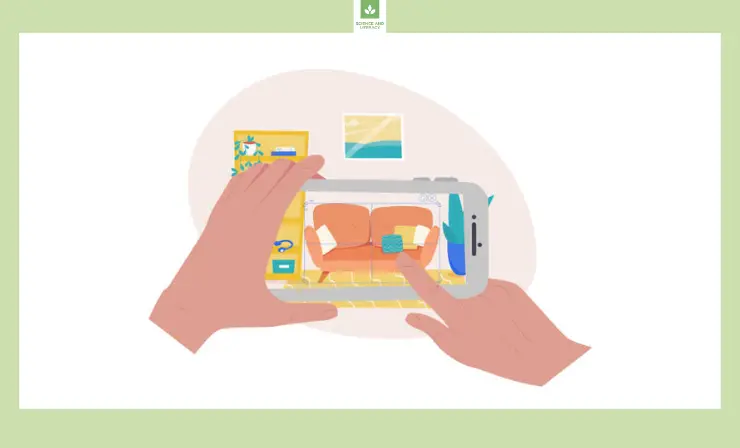
7. Recording and Editing Multimedia Projects
In the classroom, cell phones empower students to create multimedia projects by recording videos, capturing photos, and editing them on the go. This hands-on approach facilitates deeper understanding, promotes creativity, and enhances presentation skills. By producing and refining content, students learn both the subject matter and vital digital literacy skills, preparing them for modern, tech-driven environments.
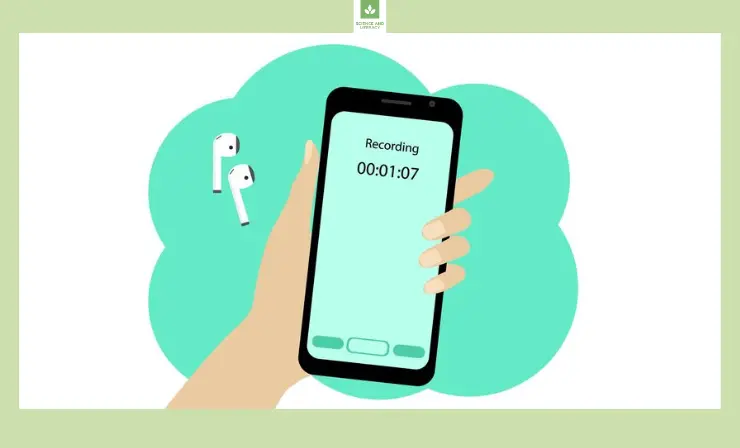
Once your school has settled the debate over whether gadgets should be allowed in school and decided to let students use these valuable technological resources, it is essential to teach proper phone and technology etiquette to your students and develop systems to manage cell phone use in your classroom. Using mobile phones in the classroom properly is key; they should not be a distraction or something that gets in the way of learning.
In this video, CJ Reynolds is talking about tips that he uses to keep kids off their phones without making it a big deal.
Share these rules for digital etiquette with your students to help ensure phones are a beneficial tool, not one that distracts from learning.
Put your phone down when someone is talking to you and make eye contact with the speaker. Don’t text while you are walking. Be aware of your surroundings and don’t get distracted from someone or something important. Silence your phone when you are in class. Remove your headphones if someone is trying to talk to you. Don’t post on social media during the school day. Be a good digital citizen and avoid getting into any digital drama. Know the cell phone policy for each of your teachers, and respect it when in their classroom. Don’t make your teacher, classmates, friends, or family secondary to your phone.
Watch more about digital etiquette in this video by Rich Colosi Media.
Additionally, if you’re interested in crafting your own phone policy, please refer to our specialized article on the topic.
Useful Resources
- Cell Phones in School: Let’s Talk about the Pros and Cons
- What is Classroom Management?
- 19 Big and Small Classroom Management Strategies
Final Thoughts
There are some pros and cons to consider regarding using cell phones in the classroom. However, given all the benefits that were shared above, I think the reasons to allow mobile phones in school far outweigh the reasons against allowing them. Allowing students to use their gadgets in the classroom will help keep them engaged in learning and provide them with instant access to technology, tools, and resources to help them learn.
So, now that you know the answer to the question, “why should students be allowed to use cell phones in class,” has your thinking changed? How do you see yourself using mobile phones with your students?
- “Number of mobile phone users worldwide from 2015 to 2020”, Statista
- “Share of Americans owning a smartphone in the U.S. as of June 2023, by age”, Statista
- “Should you let your kids have a cellphone in school?”, USA TODAY
- Education Awesomeness
- The Daring English Teacher
- EdTech Endeavours
- A.J. Juliani
- “Should the Cell Phones Be Allowed in Schools”, DebateWise
- “Cell Phones in School: 11 Reasons Why They Should Be Allowed”, StudentTutor
- “What age are kids when parents first buy/give them their own cell phone?”, Statista
- “School Shootings Are Fueling the Debate Over Cellphones in Class”, Education Week
- “Smartphones can improve academic performance, when used appropriately”, phys.org
- “School Communication and the Environment”, Schoolstream
- “Building lifelong learning, with the help of technology”, University of Washington
- “The Importance of Promoting Digital Citizenship for Students”, School of Education
- “Using Smartphone Cameras To Improve Student Organizational Skills”, National Education Association
- “How I use my phone as assistive technology in class”, Perkins
- “Mobile Learning Can Promote Student Creativity When Done Right”, Campus Technology
- “Cell Phones In The Classroom: Learning Tool Or Distraction”, Oxford Learning
- “Should Cell Phones Be Allowed in School?”, School of Education
- Recent Posts

Simona Johnes is the visionary being the creation of our project. Johnes spent much of her career in the classroom working with students. And, after many years in the classroom, Johnes became a principal.
- Exploring the Evidence: 7 Comprehensive Reasons Why School Should Start Later for Enhanced Student Well-being and Academic Success - February 15, 2024
- Why Students Should Learn a Second Language for Future Success: Exploring the 7 Benefits - February 12, 2024
- 9 Reasons Why Teachers Should Accept Late Work: Balancing Discipline and Flexibility in Education - January 31, 2024
My principal seems to have an old-school thought process about cell phones in school and has completely banned them from being out in the classroom. I’d like to let my students use them for instructional purposes. Any tips on how to change her thinking?
That is tough. I’d start by finding some other teachers in your building that share your opinion and come up with a plan to present to your principal together. Bringing data, like what I shared in the article, about how cell phones can benefit students in class could help you make your point.
I love the artice and am using it for an assingment if you see it your name or website will be on it.
Thanks for the article it is truly an elaborate article, thanks for sharing it.
yes, this is fab
my teacher does not allow phones
my whole state banned phones in class TvT
I feel like you should be able to use your phone at passing periods and breaks and also lunch.
this is a common question people ask me I 57 year old male once allowed my kids to have phones in class but one pranked called the police so I say no
This is a nice source for my citation C: Thank you.
I am writing a speech to present to my class to persuade the teachers to allow more phone usage in class, thank you for your point of view and the information.
You’re welcome!
thanks so much! this will help a lot with a project I’m doing
I am making a debate speech this is really helpful thank you!
I was not born with this new technology, cell phone, I had to learn it. Now, I am a teacher and honestly, it is great as a tool for students to use but it’s also a deterrent. Like my wife says, “You give a mouse a cookie and they will ask you for a glass of milk”. Students seem to confuse rights with privilege. My students honestly believe that they have the right to use a phone whenever they want, this includes during a class, versus asking permission. Unfortunately, others do not use it appropriately. I have no problems with the use of cell phones, as long as it is for academic achievement, but not as a school alternative (ignore teacher and ignore daily task).
Thank you for sharing your thoughts with us! We completely agree about the inappropriate use of phones.
thank you! so much i don’t know what i would do without this information!
Thank you for this essay
The essay has good information but I want more. You are telling me about the technology benefits but that’s what the Chromebooks are for. So if you could give me a stronger argument I would definitely agree.
Thanks for letting us know. We will take your wishes into consideration
All nonsense!
Phones are by far the biggest distraction for teachers to deal with. You can’t compete with the entertainment value of their phone and when you have them out it away…they are still thinking about how to get around the rule. TOTAL BAN is the only way!!!
Students can not handle these devices!!!!
Thank you for sharing your opinion. I still believe there are many ways to get students’ attention in the classroom rather than on the phone.
I always enjoy the creative ways technology can be used in schools. The mix of video talks, blog ideas and teacher input this post are great ways to share ideas. Thanks for the modern takes on how to use phones in the classroom, it is refreshing!
My pleasure!
I NEED THIS FOR MY ESSAY. THANK YOU!
I believe that cell phones in schools should be friends not enemys
thank you so much
We need our phones for SAFETY ?
This was very cool and so many good reasons why we should be able to use our phones in class!
This was very helpful imformation
I appreciate this article it is so supportive and believes in this article thanks ✌
four big guys is crazy lol four big guys and they grab on my thighs
i agree they should allow phones in school but just when were are really stuck or bored. so that is why i think that.
Hey! Thank you! I needed this for my ELA class argumentative writing prompt, this information was very useful. Since my school has a no phone-in-class rule, I can’t even have it with me in my bag! The only time I have on it during weekdays is at home and on the bus. But anyways this information was essential for my project. Thank you! 😀
You’re welcome!?
This is so helpful for argumentative essays! Thank you!
Thay can be good use for kids that walk home from school or to school or both.
In many school districts, the students borrow laptops, so they don’t need cell phones. Teachers may use software to restrict the laptops to their selected educational websites. Cell phones have disrupted learning, so they must be banned or jammed in the classroom. However, when students aren’t distracted by cell phones, they will gradually become worse at running around, yelling, and fighting, like they did before their cell phone addictions. We need consistent discipline. Disruptive students should learn with fun programs on a computer in separate rooms, instead of infecting other students with bad attitudes. After a year of learning on a computer, they can try the classroom again. We also need online video in the classrooms, so everyone, especially parents, can see the discipline problems in schools. When white schools have strict discipline and cell phone bans, but minority schools don’t, which students will get the high-paying better jobs? This is racism.
I agree with this as a student! But unfurtently my school is very old school so they banned cellphones.
Thank you for this helped me with a essay im doing for school. 🙂
i agree so much?
thank you for the info cause i have been having trouble finding an article like that and i found one so thank you!?
I forgot to put that i’m having a debate about using cell phones in class.
Im a current high school student and honestly what I’ve seen is the exact opposite of this. first period English is just a majority of people being on their phones. Unless a teacher is very strict about phones usually nothing is done about it. Honestly my parents disallowing me to bring my phone to school is what changed my grades for the better for the rest of the school year up until now. Also, some students might argue for these points but it’s usually only used as a scapegoat to make the excuse of “Oh but this article says it’s good to use phones!” Still, I’ve seen phones do so much more negatives than positives as well as the points listed here barely ever being utilized.
Yes i think they should allow it for many reasons
Coming in from Parker Middle School so I am doing a essay on why we should be able to have phones in schools and even class rooms and I was wondering if you could have your word to support having cell phones in school.
phones are what brought you into this world be thankful
I love the way you used cell phones in the classroom. Me personally-I use mine for extracurriculars.
As a High School teacher, I pretty much dislike the use of cellphones. If used for emergency, yes that’s a legitimate argument and in such case, cell phones need to be accessible to students in case of an emergency. However that would be the only reason cellphones should be allowed in classrooms. I studied high school without a cellphone and I was able to be engaged, organized and learned by using other technologies. This article doesn’t mention the pros and cons of allowing cellphones in classrooms and does not consider if the benefits weigh more than the disadvantages.
Thank you this website is amazing hope I get an A+ for my argumentative essay. Wish Me Luck!
Thanks I will use this for my topic
As a teacher at my school, I can say the cell phones are 99% more a distraction than ever as a learning tool. All the kids on the phones during class is to play video games. and look at non educational sites so that’s why cell phones are banned in my classrooms. I would say if the kids understood accountability and are responsible, then it’s a different discussion.
i can use this for my project . Almost all my classmates try to sneak there phone in class . But they always get in trouble . They don’t need a phone becuase it is can make you fail class and other things that is a proably
Very valid points. I am using you as a source for my essay. Thank you.
Thanks this helped me with my Delve Project
Hi, my name is Eli and I am an 8th grader at Indianola Middle School in Iowa. I am doing a research project about a topic of my choice and I chose to research Should phones be allowed in class. I think you would be a great person to give me more information about this topic because you gave great points and reasons why phones should be allowed in school classrooms.
Thank you so much for this article, Love your work!!!
Leave a Comment Cancel reply
Save my name, email, and website in this browser for the next time I comment.
Persuasive Essay: Should Cell Phones Be Allowed in Schools
Banning cell phones in school? Allowing students to use their cellphones in the classroom is
a controversial topic. But students have already found ways of using cell phones in school for academic purposes. After all, allowing cell phone usage can help students during the day by learning in a way they are comfortable, keeping in contact with their parents, and devices provide easy access to information. I do not agree with the cell phone ban!
First of all, allowing cell phone usage lets students learn in a way where they're comfortable.
Cell phones are like a tool to students these days, it helps them in many ways and it makes them feel comfortable and learn better. According to the text, “Smartphones are young-person intuitive. More and more students know how to use them, and they are becoming the most used "tool" by teens "(The SHARE team, resilient educator). In addition, allowing students to use their cell phones keeps them in contact with their parents. And know there are phones in schools but parents feel safe to know that their children can reach them at any moment. Based on the text, "Contacting parents mediated by school sometimes takes time so one of the best options is if the student can contact them directly. This is especially useful during medical emergencies. There are also times where the parents need to get ahold of their child for some important reason or just to check up on them on why they are running late "(Todd VanDuzer, student-tutor).
In fact, letting students use their phones in schools also lets them access information easier.
Some students may find it hard to keep on top of all their assignmens and by giving them access to information on the internet they can learn more about the topic and help them be on top of their work. As said in the text, "If smartphones are allowed in school, students will have easy access to more information and therefore will be more participative during the class discussion" (Todd VanDuzer, student-tutor). Being able to search up facts in just a few clicks is one of the biggest advantages of using technology.
On the other hand, Cell phones in the classroom promote cheating. There are many websites, online forums, and tutors available online. Most of the websites require subscriptions. These resources, allow students to ask a question about their homework and they will be provided the answer. If a student is allowed to bring their cell phone, he will have access to submit his question and receive the answer. As said in the text "As said before, kids are getting distracted and not paying attention, so when it comes to taking a test they have no idea what the answers are so many students will cheat and not even learn anything" (Amie Vitello, Middle Borough TV).
In conclusion, cell phones should not be banned from schools because they are used for academic purposes. They provide quick access to knowledge, and they are learning in a method that is comfortable for them, and they can maintain in touch with their parents. In the end mobile devices have their benefits. So, should we ban them?
Related Samples
- Smartphones Should Be Banned in Schools Essay Example
- Comparing And Contrasting My Current Use of English and Academic Language Tier I Need to Success
- Essay Sample about Aperture in Photography
- The Unhealthy Diet of College Students Research Paper
- Essay Example on STAAR Testing
- Essay Sample about Career in Digital Marketing
- Narrative Essay Sample: Challenges in High School
- Essay Sample about Brown v. Board of Education
- The Negative Effects Of Sleep Chronic Deprivation Among Teenagers
- How Technology Effects Children Essay Example
Didn't find the perfect sample?

You can order a custom paper by our expert writers
Weighing the Costs and Benefits of Cellphones in Schools
- Posted August 10, 2022
- By Emily Boudreau
- K-12 System Leadership
- Teachers and Teaching
- Technology and Media
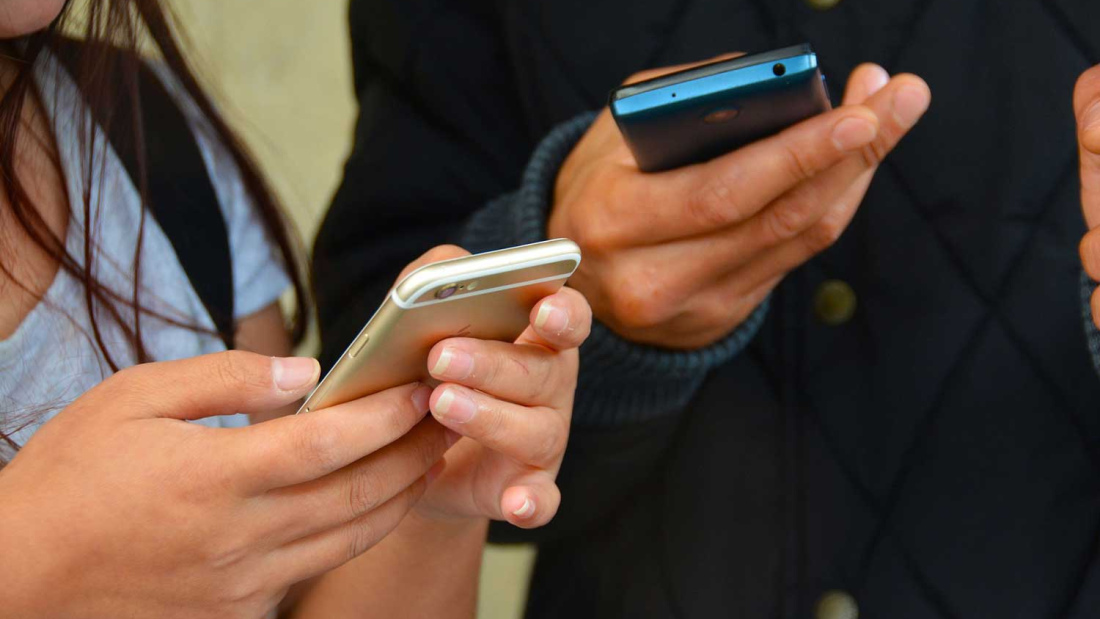
Typically, the discussion around cellphones in school — whether they are learning tools or distractions — has revolved around their impact on measures of academic success like test scores or grades. But in his research, Ed School alum Dylan Lukes looks at other outcomes policymakers should be considering.
“I’m hoping to move beyond thinking about test scores and consider the potential importance of other outcomes like discipline and school culture which may factor into student wellbeing,” says Lukes, Ph.D.’22.
As schools are gearing up for the fall, with some considering new and amended policies on the use of cellphones in class, Luke gets into his findings — including how the New York City Department of Education’s (NYCDOE) recently reversed cellphone ban impacted student suspensions and school culture — and gives his thoughts on what schools and districts should be considering when creating policies around technology moving forward.

Why are cellphones in schools such a contested topic among educators, parents, and students? The motivation for many of these policies comes from a desire to limit distractions. If you think about it, from a school’s perspective, if a cellphone ban can improve student learning, that’s a great low-cost intervention with a favorable benefit-cost ratio. However, from a parent’s perspective, the calculus is a bit different, and the cost of not being able to get a hold of their kid(s) may outweigh any potential benefit accrued from the ban.
How have cellphone policies evolved over the years? Over the past several decades, many large urban school districts have intermittently experimented with cellphone bans. However, most cellphone bans have been repealed due to their unpopularity with parents and students and concerns over equity [ as low income students often have mobile-only access to the internet ]. In March 2015, the NYCDOE lifted their longstanding districtwide cellphone ban and provided schools with significant discretion in designing and implementing school-level policies governing student cellphone use — and that shift is what I explore in my research.
Most research around cellphone use in schools looks at the impact on test scores, reaction time, and the ability to focus. You look instead at two areas: discipline and a sense of safety. The existing studies provide evidence that allowing phones in the classroom negatively impacts test scores and long-term learning retention. There are some correlational studies that suggest negative relationships between off-task device use and student achievement. Further, in psychology, research on multitasking generally finds negative effects on learning and task completion and, more generally, research has shown that cellphones distract and negatively impact reaction times, performance, enjoyment of focal tasks, and cognitive capacity.
In my research, my thinking was that as schools consider removal of bans or enforcement, they should also consider often overlooked dimensions of school culture that could play a role in educational productivity and student wellbeing. That is not to say academic achievement is not important — it is — but there are other potentially important inputs that contribute to educational productivity such as school discipline and culture.
Why? From a disciplinary standpoint, if the school has a cellphone ban and there are students breaking that cellphone ban, it’s possible that over time — and I’ve seen this from survey responses from NYCDOE school principals and parent coordinators — at some point there can be some punitive measures if you’re caught breaking that ban. That’s one of the reasons I explore the impact on discipline and suspension — you could be using a cellphone which, yes, could be distracting, but even more negatively, have the student removed from school. That kind of impact on learning could be a net-negative, even when you consider that against the positive effects a cellphone ban may have on a student’s learning and their peers’ learning.
I also think it’s important to look at other factors we don’t typically think about, like school culture, that might also have a big impact on learning.
And what did you find? So just as a disclaimer, there might be policies I can’t control for that impact these outcomes. For example, in 2014, there was a new chancellor [in New York] who made changes to the discipline code. With that caveat, I do find that the ban removal positively impacted school discipline but had negative impacts on student perception of school culture across the dimensions of respect, student behavior, and school safety. It also had negative impacts on teacher perception of school safety. My findings suggest an improvement in educational productivity due to the NYCDOE’s ban removal. But there’s a tradeoff — a cost to school culture.
What do you mean by safety? When it comes to emergencies, students likely feel safer having access to a phone. But the day-in and day-out component of school safety is how students use phones within school. This might include things like bullying, harassment, videotaping, and posting to social media. Those are reasons why having phones within schools could potentially be accelerators of negative student behavior. These safety measures which look at how safe students feel in classrooms, hallways, locker rooms, cafeterias, show a pretty negative jump after the ban has been lifted, which suggest to me that having a phone is at least interrupting a student’s ability to safely navigate those spaces.
So what should policymakers think about moving forward? This is just the tip of the iceberg. It would be interesting to look at how cellphones further contribute to school culture using more robust measures across time. And to be clear, I don’t think there’s anything inherently bad about cellphones but I do think it’s key to engage in a discussion around the tradeoffs of having them in schools and classrooms. There might be some interesting ways to balance the tradeoffs of their distractions and their benefits — something like having magnetized pouches and allowing students to take out cellphones under special circumstances (e.g., class activity, lunch). Some schools are already experimenting with these alternatives and there are some prime opportunities in this space to evaluate impacts of these polices on educational outcomes, including school discipline and school culture.

The latest research, perspectives, and highlights from the Harvard Graduate School of Education
Related Articles

Lessons Learned: Zid Mancenido, Ph.D.'22

Lost in Translation
New comparative study from Ph.D. candidate Maya Alkateb-Chami finds strong correlation between low literacy outcomes for children and schools teaching in different language from home

Informing Policy in a Time of Disruption

ChatGPT for Teachers
Trauma-informed practices in schools, teacher well-being, cultivating diversity, equity, & inclusion, integrating technology in the classroom, social-emotional development, covid-19 resources, invest in resilience: summer toolkit, civics & resilience, all toolkits, degree programs, trauma-informed professional development, teacher licensure & certification, how to become - career information, classroom management, instructional design, lifestyle & self-care, online higher ed teaching, current events, 5 benefits of using cellphones in school: smartphones as learning tools.

Today’s students are digital natives. Nearly three out of four teenagers have access to a smart phone, and so many students take them to school every day . For some teachers, it’s probably more uncommon to see a student without one than with one.
But are cellphones in the classroom a good idea? Do they serve as a valid learning tool or, or are they just another distraction contributing to the social disengagement of children?
We took a look at the arguments for using cellphones in class, along with the number of students with phones and the number of apps available to them.
Smartphone ownership
Cellphones have obviously come a long way since the two-pound, $3,995 Motorola DynaTAC 8000X was first introduced in 1984. Subsequent generations of mobile phones continued to evolve and became more affordable and portable, and now offer so much more value beyond a means to call others.
In the ongoing discussion surrounding the efficacy of digital devices in the classroom, schools must face the fact that smartphones are already being utilized by students of all ages. According to an eMarketer article referencing a February 2016 survey by Flagship Research, “Among the 14- to 18-year-olds polled, 87% said they ‘own and use’ a smartphone—i.e., penetration about a dozen percentage points higher than eMarketer’s figure for 12- to 17-year-olds.”
Clearly, young people are acquiring smartphones at a staggering rate.
App availability
Get this: The Apple Store had 800 apps the month of its launch in July 2008. As of January 2017, it had 2.2 million. How many educational apps are there? According to New America , as of June 2015, there were over 80,000 educational apps available in the app store.
From colors to ABCs to “The Little Engine That Could,” what used to be taught through books can now be learned through apps—and that’s just for younger generations. The applications for using smartphones from preschool through college are in place and growing.
Why smartphones should be allowed in school
With the widespread use of smartphones by younger and younger students, what are the practical reasons for allowing smartphones as a learning tool in the classroom? Consider these points:
- Students learn in a way they are comfortable. Smartphones are young-person intuitive. More and more students know how to use them, and they are becoming the most used “tool” by teens.
- Students can get answers quickly. Smartphones provide the ability to get answers really fast. In some situations, a student may not ask for clarification to a question he or she has in an open classroom—because they can use their smartphone to get the answer they’re looking for.
- Audio and video can bring learning to life . Audio and video capabilities of smartphones can put a voice to John F. Kennedy, a dramatic video image to the Hindenburg disaster, and allow students to hear the music of Chopin or Al Jolson. They can even connect students with other students from around the globe and expand their learning world.
- Access to educational apps. Equipping your classroom with handy learning apps takes learning up a notch. There are many educational apps available in a wide range of subjects for all kinds of learners. These game-like exercises encourage playful competition among your students, while enhancing the way they learn new ideas. Plus, students (and you, the teacher) will love the change from regular lecture instruction.
- Smartphones allow for social learning . Smartphones can allow students to work in groups on projects, sharing information and discoveries. They can move toward a common goal, again, in a format they are comfortable using.
How to, not if to, use smartphones
Challenges of leveling the playing field, maintaining proper use and control, and preventing abuse with smartphones are similar to problems faced by teachers in the past. Back then, it was passing a note; today it is texting. Both are fairly avoidable, but it doesn’t mean phones should be banned (paper wasn’t!).
We believe the focus of smartphone use in the classroom should shift from not if they should be used, but how to best use them. While critics will cite the opportunity for cheating, unauthorized socializing, and social isolation issues involved, the fact is students are using smartphones every day, and they are using them to learn. Teachers can be a positive force in helping students use them properly in the classroom.
Our advice: set ground rules for smartphones in your classroom, along with clear expectations of what happens if they’re used inappropriately. Just like with anything else, too much of something can be a bad thing—but just enough, can be perfect for learning in new ways.
Further your knowledge about the digital classroom
Here are more articles to enhance your understanding of how digital devices can affect learning:
- Driven to Distraction: The Device Debate
- Pros and Cons of Allowing Digital Devices in the Classroom
- What is BYOD? And Why Should Teachers Care?
You may also like to read
- Cooperative Learning for Middle School Math Class
- Benefits of Teaching at a Charter School
- 5 Ways to Design a School for Brain-based Learning
- Using Learning Stations in Middle School
- Avoiding Summer Slide: Strategies to Keep Kids Learning While School's Out
- Professional Students: Benefits and Risks of Working While in High School
Categorized as: Tips for Teachers and Classroom Resources
Tagged as: Educational Technology , Engaging Activities , Pros and Cons
- Online & Campus Doctorate (EdD) in Administra...
- Online Associate's Degree Programs in Educati...
- Online & Campus Bachelor's in Secondary Educa...

Cell Phones in School: Pros and Cons

Khadija Bilal

Cell phones and smartphones are a big part of modern life. Many people use them every day, including kids and teens. But there’s still a debate about cell phones in school. In this guide, we’ll look at some arguments for why should phones be allowed in school, while also addressing some common concerns parents may have.
Interesting Facts and Statistics About Cell Phones in Education
How cell phones can be used effectively, what are the pros of allowing cell phones in school, what are the cons of allowing cell phones, are there any alternatives, should kids have cell phones in school.
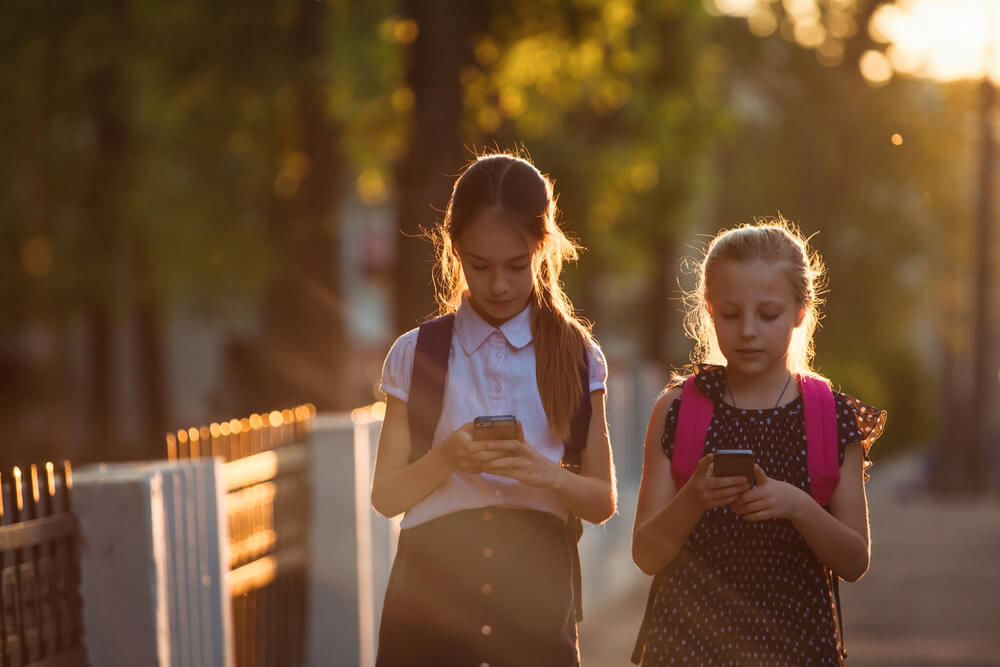
iVazoUSky/Shutterstock.com
Before we look at some of the pros and cons of cell phones in school, let’s look at some statistics to get a clearer picture of the situation.
- 53% of children will own a smartphone by the age of 11 in the US
- That number increases to a whopping 95% in teenagers
- Surveys show that as well as passing the time, 83% of kids use their phones to learn
- Cell phones are the favored tool of communication among modern teens
- 41% of teens from lower-income households use their phones to access the internet
- Studies show that learning on mobile devices can boost productivity by over 40%
- Teens can spend over 7 hours a day looking at screens
These are just some of the many, many statistics about cell phones among teens and in the education sector. From this, we can see that mobile and cellular phone technology is a big part of life for today’s teenagers, and cell phones in school do have the power of providing super educational opportunities.
At the same time, with so many kids spending hours a day staring at their phone screens, there’s also a risk that a phone in school could be too much of a distraction. This means that authorities need to weigh up the pros and cons before deciding about banning or allowing phones.

Ground Picture/Shutterstock.com
Many parents and teachers worry about the risks or downsides associated with using cheap phones at school. However, there are plenty of ways in which children can use these devices for educational and beneficial purposes.
Educational Apps and Games
One of the most obvious ways in which cell phones can be used effectively for education is through the many educational apps and games out there. Mobile app stores are filled with educational content for kids of all ages.
There are apps designed to help kids learn languages, for example. There are also tools and games to help with every school subject, from math to geography.
Related: The 30 Best Educational Apps for School .
Digital Learning Materials
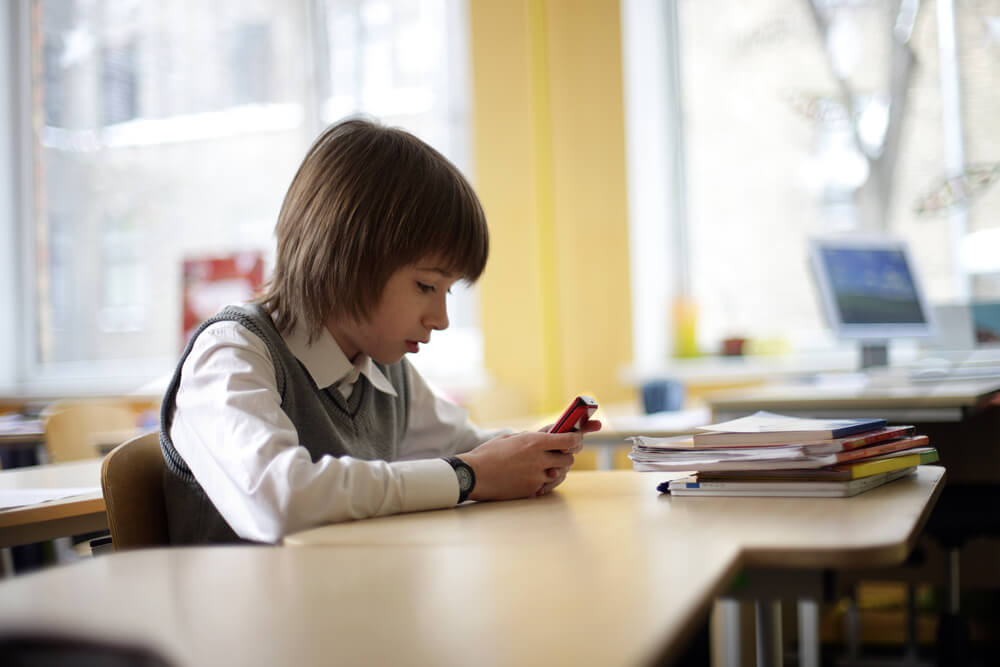
Anna Jurkovska/Shutterstock.com
Giving kids access to their phones at school allows them to use an almost endless library of digital learning materials. There are countless educational documents online, from scientific research papers to exam tips and more.
This can be very beneficial in a school environment. If a child doesn’t quite understand a subject, their teacher can help them by sharing digital learning materials that explain the idea in other ways.
Videos, Podcasts, and More
Every child has their own way of learning. Some like to learn by repeating and memorizing information over and over. Others are more visual learners and want to see ideas and concepts represented with images to get a strong understanding of how they work.
A great thing about using phones and other devices is that they can access all sorts of different digital materials. There are videos about scientific processes, podcasts discussing literature, and long-form articles on mathematic principles, for example.
Cell Phone eReaders
Reading is one of the crucial skills that all children are taught during their early school years. Being able to read well is so important in later life. This skill allows children, teens, and adults to read and understand countless resources, from books to articles and encyclopedias.
A great way that phones can be used in schools is as digital eReaders. It’s easy to download an eReading app onto a phone and then read digital versions of books and documents. This also has eco-friendly benefits, as it removes the need for paper or physical versions of books.
Online Encyclopedias
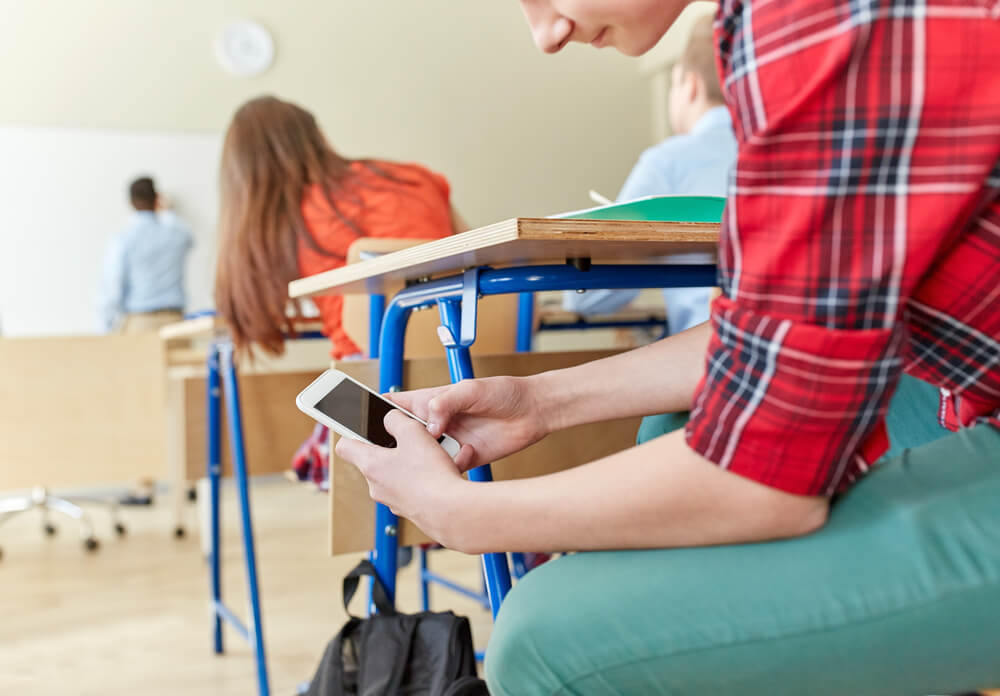
Another useful way in which phones can be effective at school is by giving kids access to online encyclopedias, like Wikipedia. These educational resources are very powerful, filled with reams of information and knowledge for kids to soak up.
Children can use their phones to look up the different topics they’re taught at school. This can help to deepen their understanding of almost any subject. It also provides supplementary information that the class teacher might not mention.
Screen Control Apps
One of the common problems that people cite when it comes to phones in schools is that they can be distracting. Many parents and teachers worry that kids will spend too much time looking at their phones and not enough time paying attention in class.
However, a way to combat this is to make use of screen control apps. Apps like Kids360 , for example, allow you to track and control how much time your child’s device is on.
Collaboration and Group Work
Often, teachers put kids into groups and ask them to work together on a project. This is a great way for kids of different ages to not only build new social bonds but also develop their teamwork skills.
Phones can be helpful tools for collaboration. They facilitate communication between the different team members, letting everyone participate, even after-school when the various team members say goodbye and go home for the day.
Related: What Age Should a Kid Get a Phone? The Ultimate Guide to Deciding .

Zivica Kerkez/Shutterstock.com
Clearly, when it comes to phones in schools, there are both pros and cons. Let’s take a look at some of the advantages.
A Powerful Learning Tool
One of the best benefits of allowing cell phones in school is their incredible potential for educational benefits and stronger learning.
As shown above, there are lots of ways that phones can be used for learning. They give access to eReaders, educational apps, online encyclopedias, and more.
An Additional Security Measure
Another benefit of letting kids take phones to school is for their own safety. If any kind of emergency happens, the child will be able to make a call and get help or contact their parents.
Not only that, but phones can be helpful for safeguarding kids outside of school, as they make their way home. Parents can use the Findmykids app to track their child’s location and keep them secure.
Download the Findmykids app today for free and be sure your child is safe wherever they are.
Communication with Friends and Family

Despite having so many different uses nowadays, the primary purpose of a phone is for communication.
Phones at school can help kids keep in touch with one another, work together on group projects, and build strong friendships.
Organization
Many students struggle to stay organized. It can be hard to keep track of homework, schedules, assignments, exams, and so on.
Phones make organization easier. They come with calendar apps and other handy tools to help kids organize their lives and become more independent.
Saving Schools Money
Phones can also provide benefits for the school itself. Instead of having to spend lots of money on school devices like tablets or iPads, the school can simply ask students to use their phones.
eReader apps can remove the need for investment in books, and phones could therefore help schools with limited budgets or resources.
Helping Children from Lower-Income Homes
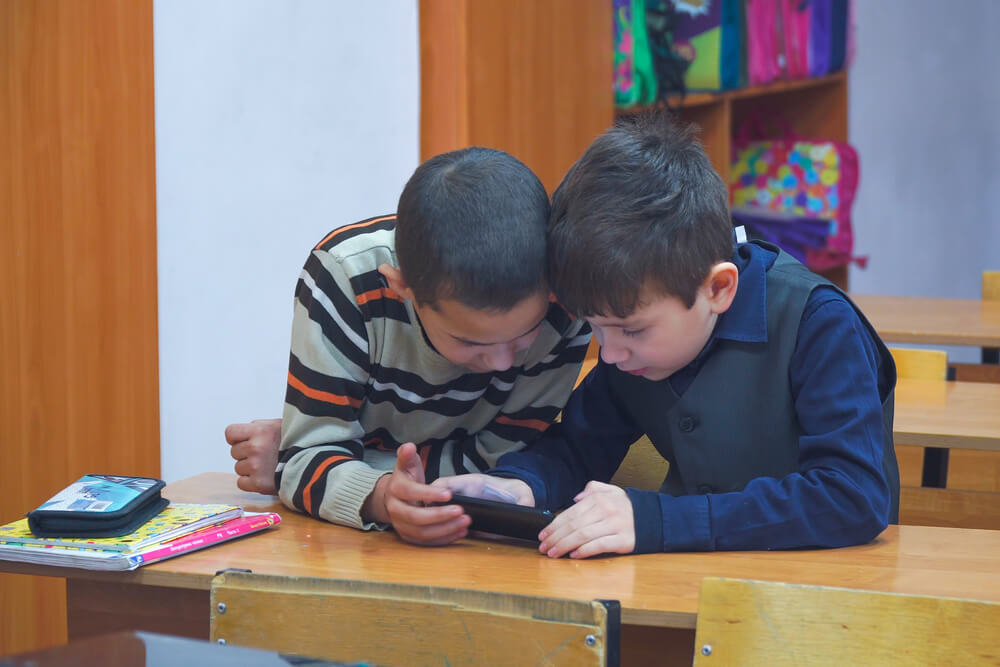
Proshkin Aleksandr/Shutterstock.com
Another financial-related benefit of phones at school is that they might be able to help kids who come from lower-income homes.
Some kids don’t have internet access or computers at home. Being able to use a phone at school can give them the knowledge and tech skills they need to succeed later in life.
Teaching Kids Tech Skills
Technology is an integral part of today’s world. Kids will need to know how to use various technological tools like phones, computers, and the internet as they grow up.
Bringing phones to school will help to level the playing field and give all kids the chance to learn about how to their devices in the best ways to access knowledge and learn skills.
Teaching Digital Responsibility
If kids aren’t taught the rights and wrongs of using their phones, they may have to simply figure things out for themselves. This could lead to bad habits and serious mistakes being made in their future.
Bringing phones to school gives teachers the chance to teach children about digital responsibility. It can teach them when it’s allowed to use their phones and how to use them in a way that is respectful of others.

As well as the pros listed above, there are also several cons to take into consideration regarding phones in schools. Here are a few of the big concerns:
A Distraction
One of the big issues that many people talk about with phones in schools is the risk of them becoming a distraction. Kids could start looking at their phones while the teacher is talking and miss out on valuable information, for example.
There’s also a risk of kids being less likely to interact and socialize together if they’re too distracted by their screens and devices.
However, this disadvantage can be easily dealt with. For example, you can install the Kids360 app and make a schedule for using the gadget—restrict access to games during school and before going to bed and monitor which applications and how long the child is using.
Mental Health Effects and Addiction
Some studies have shown that phones could have a negative effect on a child or teen’s mental health. It’s even possible for children of varying ages to develop addictions or dependencies on their devices.
This is why phone usage needs to be carefully monitored, controlled, and balanced. If a child is allowed to use their phone non-stop, they could easily become addicted to them.
Possible Cyberbullying

Daisy Daisy/Shutterstock.com
Bullying has always been a big problem in schools across the globe. It has changed form over the years, with cyberbullying becoming more prevalent in modern times.
With cyberbullying, bullies can use the internet and technological devices, like phones, to send harmful messages or spread false rumors about their peers. This can be very damaging to the victims.
Read also Children and cyberbullying: what is it and how to stop it?
Risk of Cheating
Another possible downside to consider with allowing phones in schools is the risk of cheating. During an exam, for instance, a student could use their phone to look up the answer to a question.
This kind of behavior could damage the integrity of the examination process. It could also make children too dependent on their devices and cause them to get false grades that are not reflective of their true abilities.
Potential for Misuse
Of course, with any internet-connected device, there’s also a risk of phones being misused by children. Instead of using them for educational purposes, kids could simply play games or watch videos.
There’s also a chance of children being able to access unsuitable content on their phones via the internet. For this reason, any phone usage at school would need to be carefully monitored.

EZ-Stock Studio/Shutterstock.com
If, after weighing up the pros and cons of phones in schools, you feel that phones should be banned or strictly controlled, you might like to consider an alternative. So, are there any other devices out there that can provide similar benefits and uses?
In general, the only alternatives to phones are other devices that function in a similar way, like GPS and smartwatches, or laptops and tablets. These devices allow access to educational materials and apps, but also have many of the same risks and downsides as phones.
Choose a GPS watch for a child right now and be calm for the safety of your child wherever they are!
Everyone will have their opinion on whether or not phones should be allowed in schools. However, after weighing up the pros and cons, it’s arguable that the benefits of phones outweigh the risks and kids should be allowed the opportunity to use their phones in certain ways at school.
These technological tools are part of the world, and kids will use them throughout their lives. By bringing them into the school environment, it should be easier to teach children and teens the right ways to use their phones for educational purposes, rather than simply as distractions, giving them valuable knowledge and skills they can take into later life.
The picture on the front page: BearFotos/Shutterstock.com

Parents today are faced with a wide array of troubling digital content that can land…

In the ever-changing world of children’s games, the Robot Turtles board game offers something different;…

Ever since pregnancy—and often even before it—it’s the question that’s constantly on our minds: how…
Subscribe now!
Glad you've joined us🎉🎉.
Should Cell Phones Be Used in the Classroom?
When schools welcome the use of cell phones and other technologies in the classroom.
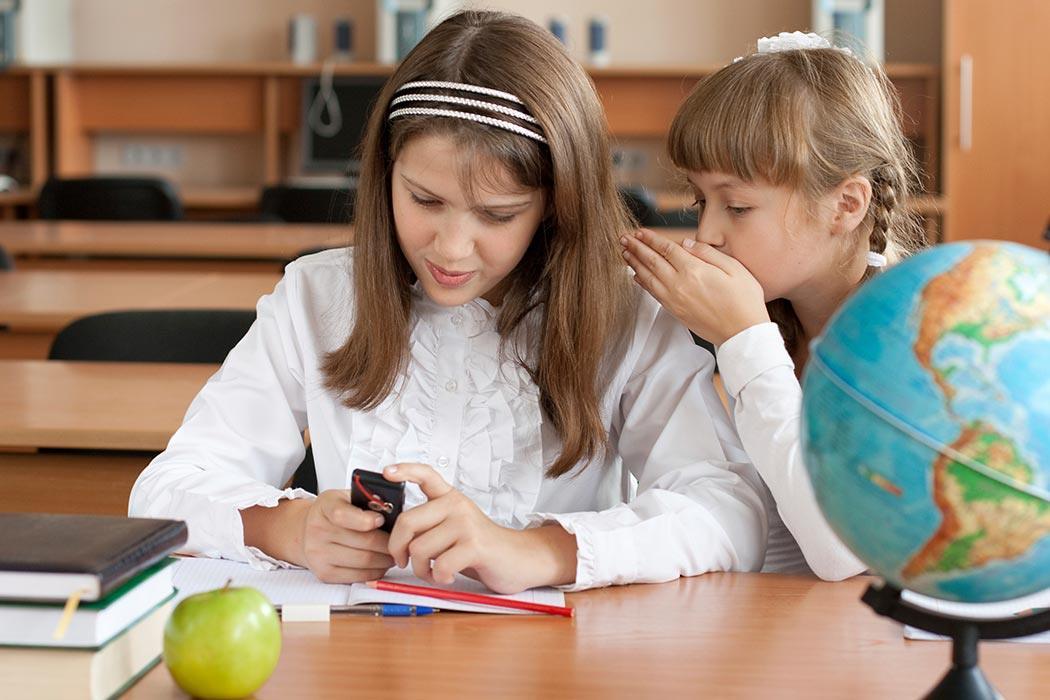
Sherry Turkle, the author of the new book Reclaiming Conversation, is focusing attention on the ways that new technology—smartphones in particular—are changing the nature of our interactions with others. This is a big issue for schools, which have an obvious role to play in shaping young people’s relationships with their devices.

In a 2008 paper for The English Journal, high school teachers Nancy Frey and Douglas Fisher explained how they helped craft a new policy to encourage students to use phones in a responsible, polite way.
Initially, the school required students to keep their phones off and put away during the school day. Phones could be confiscated if students were found using them.
This is common policy, but Frey and Fisher write that it created a lot of frustration. Teachers and administrators weren’t happy with the amount of time they had to spend enforcing the rules, and some parents got upset when their children’s phones were taken away for the day.
Beyond that, Frey and Fisher believed they were missing out on the value of integrating technology into the curriculum.
So, with input from their colleagues, they helped draft what they called a “courtesy policy” to replace the old technology policy. The new plan offered a very general mandate that students and staff “interact with one another in positive, respectful ways” that went beyond specifically limiting the use of technology. The policy promoted things like saying “please” and “thank you”, how to clean up trash properly, not texting during class, and not “hogging bandwidth and/or computer time.”
This meant that students were now permitted to text during lunch and listen to music on their iPods while doing independent work in class.
Frey and Fisher write that the faculty knew it might be hard for students to adjust to the new freedoms, but hoped the process would lead to useful conversations. They describe one student who repeatedly violated the “no texting in class” rule. By meeting with her daily, the teachers discovered that she was worried that not replying immediately to texts would damage her relationship with a newly-formed circle of friends. This gave the teachers the opportunity to talk with her about the difficulty of navigating the school’s social landscape.
The teachers also found new ways to use technology in the classroom. They added a podcast of classic stories to the English curriculum and began sending reminders about homework and “pop quiz” questions to students after school hours.
Beyond specific uses of technology, Frey and Fisher’s basic goal was closely connected to the issues Turkle is addressing: the question of how to use technology without harming our relationships with other humans.
“Our concern grew out of recognition that merely banning technology would do little to teach students how to use it responsibly,” they write. “…We have found that the basic premise—that classmates and teachers are entitled to courteous treatment—has served as a touchstone.”

JSTOR is a digital library for scholars, researchers, and students. JSTOR Daily readers can access the original research behind our articles for free on JSTOR.
Get Our Newsletter
Get your fix of JSTOR Daily’s best stories in your inbox each Thursday.
Privacy Policy Contact Us You may unsubscribe at any time by clicking on the provided link on any marketing message.
More Stories

Meet Saint Wilgefortis, the Bearded Virgin


Nice Guy Spinoza Finishes…First?

A Body in the Bog

A Mughal Mosque in Kenya
Recent posts.
- Saffron: The Story of the World’s Most Expensive Spice
- The Fencing Moral Panic of Elizabethan London
- “Spaghettification”: How Black Holes Stretch Objects into Oblivion
- From Saint to Stereotype: A Story of Brigid
- Christy’s Minstrels Go to Great Britain
Support JSTOR Daily
Sign up for our weekly newsletter.
Get Started Today!
- Centre Details
- Ask A Question
- Change Location
- Programs & More
Cell Phones In The Classroom: Learning Tool or Distraction

These days, more and more students are bringing cell phones to class. Even elementary school-aged students have cell phones in their pockets and backpacks.
However, the news of Ontario’s decision to ban cell phones in classrooms opens again the debate about whether or not students should have cellphones in school. It also brings up the question of whether it’s possible for technology to exist in the classroom as a learning tool—rather than simply a distraction.
Ontario’s Classroom Cell Phone Ban
Starting in September 2019, cell phones will be banned in Ontario classrooms during instructional time.
The new ban means elementary and secondary school students won’t be able to use their cellphones in the classroom unless it is for educational purposes, medical reasons, or as a support for students with special needs. How the ban is enforced will be up to individual boards and schools.
By banning cellphones, Ontario’s Education Ministry hopes to remove distractions so students can focus on acquiring foundational learning skills they need, including reading, writing and math.
The decision and renewed debate has many teachers and parents left wondering: can cell phones ever really benefit students in class, or are they best left tucked away?
Read on to learn more about the pros and cons of students having cell phones in school.
Cell Phone Use In The Classroom
Students check their phones in the classroom an average of more than 11 times a day. That can add up to a lot of time spent distracted from schoolwork. And when students are distracted, it’s a recipe for extra stress, frustration, and catch-up time for everyone.
With students spending up to 20% of their in-class time texting, emailing, and checking social media, it’s no wonder the debate about cell phones in the classroom is alive and well.
Learn more about the pros and cons of students bringing their cell phones into the classroom.
How Cell Phones Can Be Used Effectively In the Classroom
If properly managed, cell phones can be used as tools to help children learn in the classroom. The following are some of the pros of allowing cell phones in school:
- Using educational learning apps
Cell phones give students access to tools and apps that can help them complete and stay on top of their class work. These tools can also teach students to develop better study habits, like time management and organization skills.
- Incorporating digital platforms into lessons
Using social media can keep students interested in class and encourage them to participate in the discussion. Some teachers create twitter hashtags or message boards students can use during class discussions to share thoughts and ideas. This can be especially helpful for students who might not be comfortable speaking in class.
- Supplementing lessons with digital materials
Teachers can take advantage of cell phones by providing students with resources to find more information about a topic. This can include videos, news stories, online discussion groups, and more. Allowing students to access these resources in class can help encourage participation and discussions.
- Providing easy access to more information
The Drawbacks Of Allowing Cell Phones In Classrooms
While cell phones can be used as learning tools, it is a challenge to make sure students are using them for school-related tasks. A cell phone can easily turn from “classroom learning tool” into “classroom disruption”.
Cons of allowing cell phones in school include:
- Distractions and interruptions
When students use their cell phones to check social media and text their friends in class, it leads to distractions for those students as well as for their peers. This can cause disruptions in class, particularly if the teacher is constantly telling students to turn their devices off.
- Cyberbullying
Cell phones can also lead to increased problems with bullying on the schoolground. Cyberbullying can be harder to see than other forms of bullying, making it difficult for teachers to identify and stop when it is happening.
Cell phones can be a helpful learning tool in class. But they can also be used by students to access information while taking a test, leading to cheating. Even if a student isn’t caught, this can lead to him or her having a poor understanding of the material in the future, and is unfair to students who studied hard to do well.
- Disconnection from face-to-face activities
The Bottom Line: Should Students Have Cell Phones In School?
There’s no easy answer: there are both pros and cons to students having cell phones in school. Although they can be used as a learning tool in the classroom, this only works as long as students use them effectively.
This means for teachers who decide to use cell phones (or any other digital device) as part of their lessons, it’s important to set ground rules and keep a close eye on how they are being used.
Where do you stand on the cell phone debate? Let us know by tweeting @oxfordlearning on Twitter!
Related Resources:
Is Multitasking Bad For Students? How To Study Without Being Distracted
Five Factors That Impact Your Child’s Focus (& How To Recognize Them)
Why so many students hate math (and how to fix it), related attention & focus resources.

Attention & Focus
How tutoring can help students with adhd.

How Tutoring Benefits Students with Autism Spectrum Disorder (ASD)

Understanding Executive Function: The Importance of Working Memory

Attention & Focus, Homework
7 ways to help slow-working students, find an oxford learning ® location near you, we have over 100 centres across canada.
Why Schools Should Ban Cell Phones in the Classroom—and Why Parents Have to Help
New study shows it takes a young brain 20 minutes to refocus after using a cell phone in a classroom
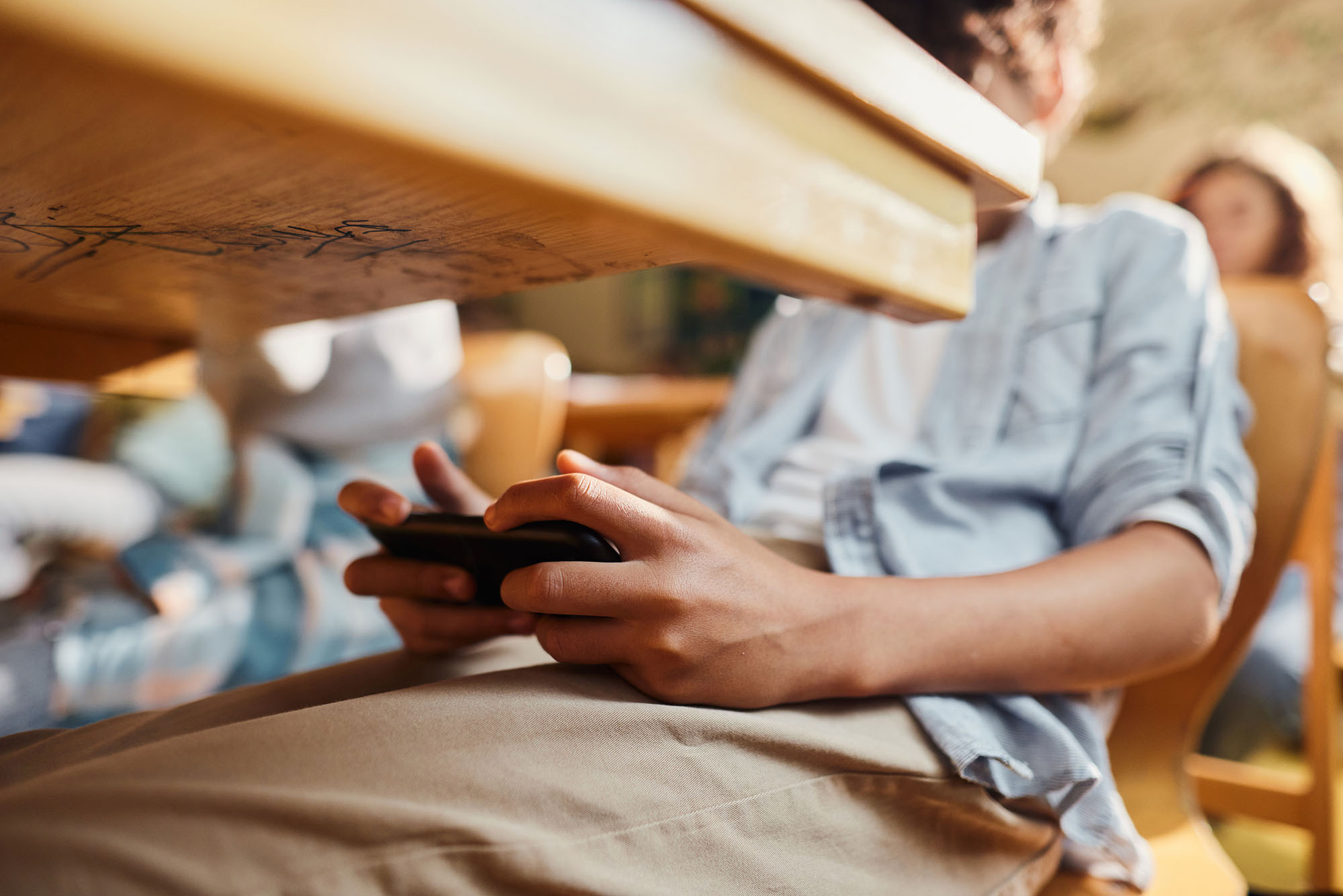
Photo by skynesher/iStock
Parents, the next time you are about to send a quick trivial text message to your students while they’re at school—maybe sitting in a classroom—stop. And think about this: it might take them only 10 seconds to respond with a thumbs-up emoji, but their brain will need 20 minutes to refocus on the algebra or history or physics lesson in front of them— 20 minutes .
That was just one of the many findings in a recent report from a 14-country study by UNESCO (United Nations Educational, Scientific and Cultural Organization) that prompted this headline in the Washington Post : “Schools should ban smartphones. Parents should help.” The study recommends a ban on smartphones at school for students of all ages, and says the data are unequivocal, showing that countries that enforce restrictions see improved academic performance and less bullying.
It’s a fraught debate, one that prompts frustration among educators, who say students are less focused than ever as schools struggle to enforce cell phone limitation policies, and rage from some parents, worrying about a possible shooting when they can’t get in touch, who insist they need to be able to reach their children at all times. And, perhaps surprisingly, it prompts a collective yawn from students.
In fact, students openly admit their cell phones distract them and that they focus better in school without them, says Joelle Renstrom , a senior lecturer in rhetoric at Boston University’s College of General Studies. It’s an issue she has studied for years. She even performed an experiment with her students that supports what she long suspected: Cell Phones + Classrooms = Bad Learning Environment.
BU Today spoke with Renstrom about the latest study and research.
with Joelle Renstrom
Bu today: let me get right to the point. do we as a society need to be better about restricting cell phones in classrooms it seems so obvious..
Renstrom: Of course. But it is easier said than done. It’s hard to be consistent. We will always have students with some kind of reason, or a note from someone, that gives them access to technology. And then it becomes hard to explain why some people can have it and some people can’t. But student buy-in to the idea is important.
BU Today: But is getting students to agree more important than getting schools and parents to agree? Is it naive to think that students are supposed to follow the rules that we as parents and teachers set for them?
Renstrom: I have made the case before that addiction to phones is kind of like second-hand smoking. If you’re young and people around you are using it, you are going to want it, too. Every baby is like that. They want to reach for it, it’s flashing, their parents are on it all the time. Students openly acknowledge they are addicted. Their digital lives are there. But they also know there is this lack of balance in their lives. I do think buy-in is important. But do it as an experiment. Did it work? What changes did it make? Did it make you anxious or distracted during those 50 minutes in class? I did that for years. I surveyed students for a number of semesters; how do you feel about putting your phone in a pouch? They made some predictions and said what they thought about how annoying it was. But at the end, they talked about how those predictions [played out], and whether they were better able to focus. It was very, very clear they were better able to focus. Also interestingly, not a single student left during class to get a drink or go to the bathroom. They had been 100 percent doing that just so they could use their phone.
BU Today: Should we be talking about this question, cell phones in classrooms, for all ages, middle school all the way through college? Or does age matter?
Renstrom: It’s never going to be universal. Different families, different schools. And there is, on some level, a safety issue. I do not blame parents for thinking, if there’s someone with a gun in school, I need a way to reach my kids. What if all the phones are in pouches when someone with a gun comes in? It’s crazy that we even have to consider that.
BU Today: What’s one example of something that can be changed easily?
Renstrom: Parents need to stop calling their kids during the day. Stop doing that. What you are doing is setting that kid up so that they are responding to a bot 24-7 when they shouldn’t be. If you’re a kid who gets a text from your parent in class, you are conditioned to respond and to know that [the parent] expects a response. It adds so much anxiety to people’s lives. It all just ends up in this anxiety loop. When kids are in school, leave them alone. Think about what that phone is actually meant for. When you gave them a phone, you said it’s in case of an emergency or if you need to be picked up in a different place. Make those the parameters. If it’s just to confirm, “I’m still picking you up at 3,” then no, don’t do that. Remember when we didn’t have to confirm? There is a time and place for this, for all technology.
BU Today: This latest study, how do you think people will react to it?
Renstrom: This isn’t new. How many studies have to come out to say that cured meat is terrible and is carcinogenic. People are like, “Oh, don’t tell me what to eat. Or when to be on my phone.” This gets real contentious, real fast because telling people what’s good for them is hard.
BU Today: I can understand that—but in this case we’re not telling adults to stop being on their phones. We’re saying help get your kids off their phones in classrooms, for their health and education.
Renstrom: Studies show kids’ brains, and their gray matter, are low when they are on screens. School is prime habit-forming time. You should not sit in class within view of the professor, laughing while they are talking about World War II. There is a social appropriateness that needs to be learned. Another habit that needs to be addressed is the misconception of multitasking. We are under this misconception we all can do it. And we can’t. You might think, I can listen to this lecture while my sister texts me. That is not supported by science or studies. It is literally derailing you. Your brain jumps off to another track and has to get back on. If you think you have not left that first track, you are wrong.
BU Today: So what next steps would you like to see?
Renstrom: I would like to see both schools and families be more assertive about this. But also to work together. If the parents are anti-smartphone policy, it doesn’t matter if the school is pro-policy. If there is a war between parents and schools, I am not sure much will happen. Some kind of intervention and restriction is better than just ripping it away from kids. The UNESCO study found it is actually even worse for university students. We are all coming at this problem from all different ways. Pouches or banned phones. Or nothing.
Explore Related Topics:
- Smartphones
- Share this story
- 12 Comments Add
Associate Vice President, Executive Editor, Editorial Department Twitter Profile

Doug Most is a lifelong journalist and author whose career has spanned newspapers and magazines up and down the East Coast, with stops in Washington, D.C., South Carolina, New Jersey, and Boston. He was named Journalist of the Year while at The Record in Bergen County, N.J., for his coverage of a tragic story about two teens charged with killing their newborn. After a stint at Boston Magazine , he worked for more than a decade at the Boston Globe in various roles, including magazine editor and deputy managing editor/special projects. His 2014 nonfiction book, The Race Underground , tells the story of the birth of subways in America and was made into a PBS/American Experience documentary. He has a BA in political communication from George Washington University. Profile
Comments & Discussion
Boston University moderates comments to facilitate an informed, substantive, civil conversation. Abusive, profane, self-promotional, misleading, incoherent or off-topic comments will be rejected. Moderators are staffed during regular business hours (EST) and can only accept comments written in English. Statistics or facts must include a citation or a link to the citation.
There are 12 comments on Why Schools Should Ban Cell Phones in the Classroom—and Why Parents Have to Help
i found this very helpful with my research
It was a great research, helped me a lot.
I think that this was helpful, but there is an ongoing question at my school, which is, though phones may be negative to health and knowledge and they’re a distraction what happens if there was a shooting or a fire or a dangourus weather event and you don’t have a phone to tell your parents or guardians at home if you are alright? (Reply answer if have one)
Yeah they would get an amber alert
well, the school has the technology that can help communicate that to the parents, and if that were to happen, I guess that’s why there’s always a cell phone in the classrooms those old-time ones, but I feel it would not be okay in case of a shooting since you have to go silence, and on the moment of fire or weather everything happens so fast in the moment.
I think that this was helpful, but there is an ongoing question at my school, which is, though phones may be negative to health and knowledge and they’re a distraction what happens if there is a shooting or a fire or a dangerous weather event and you don’t have a phone to tell your parents or guardians at home if you are alright?
I am writing a paper and this is very helpful thank you.
I am writing a paper and this is very helpful but it is true what if our mom or dad have to contact us we need phones!
this helped me with my school project about whether cell phones should be banned in school. I think yes but the class is saying no. I think it’s because I was raised without a phone so I know how to survive and contact my parents without a phone. but anyway, this helped me with my essay! thank you!
I don’t think phones should be allowed in school, and this is perfect backup! Thank you Doug
great infromation for debate
Post a comment. Cancel reply
Your email address will not be published. Required fields are marked *
Latest from BU Today
The weekender: march 28 to 31, bridge collapse creates conversation in bu structural mechanics class, terriers in charge: favor wariboko (cas’24), the bold world of marcus wachira, women’s lacrosse opens home patriot league play, comm ave runway: march edition, 10 memes that describe being a second semester senior, pov: was the francis scott key bridge disaster avoidable, does the united states have the clout to alter netanyahu’s course in gaza, undergraduate research study project explores do-it-yourself extremism, pov: the decision to reinstate mandatory standardized tests for college admissions is a mistake, bu graduate workers launch strike with rally, picket plans, bu professors, undergrads adjust and adapt as grad student strike begins, welcome to boston university, class of 2028, bu falls to bc in hockey east championship, students fasting for ramadan find a home at the gsu, psychology vs sociology: what’s the difference between the majors, pov: are all ultra-processed foods unhealthy, driving in circles: a story of healing through rock music and comedy, five faculty receive edward avedisian professorships.
Should you let your kids have a cellphone in school?
Do you let your kids take their cellphones to class? Does your school district even allow them?
Digital device policies are all over the map in U.S. schools, with parents and teachers divided on whether to curb or outright ban such phone use on school grounds.
Some schools make the kids place phones in a locker. Others require them to be checked in at the front office. But some are OK having students keep them in a backpack or pocket, so long as they’re turned off.
At some schools, the decision about whether to let a kid have a phone in class is up to individual teachers, who may be reluctant to assume the role of enforcer.
In fact, some teachers see the phones as an asset and actually incorporate phone use as part of their lessons.
Yet another question surrounds what kids are allowed to do with phones during lunch or between classes. Can they text, call, play games or use other apps then?
In July, California passed a law that gives public and charter schools the authority to prohibit cellphone use in the classroom , except during emergencies or other special circumstances, such as when a doctor determines that a student needs a phone for health reasons.
The Forest Hills Public Schools, in Grand Rapids, Michigan, revised its policy recently so that students will not be allowed to carry or use cellphones during the school day.
A similar edict is in place at Washington High School in Massillon, Ohio.
A principal expressed his happiness on Twitter about his school's policy: “Looking forward to seeing faces, not cell phones/headphones this school year!” tweeted David Lautenschleger.
What doesn't seem to be in dispute is that screen-time addiction is a problem for young and old. Kids fixated on smartphone screens may merely be modeling the behavior of mom and dad.
The case for allowing phones in class
Those who say cellphones should be permitted in schools often cite educational benefits. For example, kids might be making movies or studying photography through various apps, for instance.
“Have a plan, not a ban," Liz Kline, vice president for education at Common Sense Education in the San Francisco Bay Area, told USA TODAY in 2018.
Even those who favor cellphone use in the classroom acknowledge those times, however, when phones ought to be put away or even collected by teachers, no questions asked, namely during test time. The sad truth: Some students use phones to cheat.
Safety concerns are also often given as a reason to let kids have devices at school. When there’s an accident or tragic incident, the presence of phones lets parents get in touch with teachers and/or students.
For sure, there are times when parents may also try to text the youngsters under more routine circumstances if only to remind the kids to remind their teachers about something.
The case to kick phones out of class
The rationale against cellphones in schools is that excessive exposure to the devices will have a negative effect on school-aged kids – lowering grades, promoting cyberbullying and even increasing the likelihood of teenage anxiety, depression and suicide.
Kids can be sneaky, too. “When we’re asking these 12- to 13-year-olds to carry the phone and not be on them, we 100% know that’s not happening,” Delaney Ruston, a physician and director of the documentary “Screenagers: Growing Up in the Digital Age,” told USA TODAY in 2018.
Through her “ Away For The Day” initiative, Ruston pointed to studies that show that when youngsters don’t have the freedom of accessing their phones during school hours, they’re more engaged socially and academically.
Real-time translation: How technology will help kids not hear language differences
Ruston even dismissed the safety argument. She pointed to an NPR report in which security experts have said that letting a kid have a phone in the classroom during a lockdown makes them less safe, not more so. When students should be quiet, for example, a ringing or vibrating phone might alert an intruder where kids are hiding. Parents trying to reach youngsters in an emergency might jam communications and interfere with first responders. And the kids might miss instructions from the authorities.
Parents, what are your views on the topic? Email: [email protected]; Follow @edbaig on Twitter

14 Should Cellphones Be Allowed in School Pros and Cons
Having a cellphone has become a rite of passage for children today, much like a driver’s license was for a previous generation Many students have free access to the Internet at home. They can use their phones to text and talk with their friends, play games, take pictures, and enjoy all the other elements of smartphone ownership that are available today.
That kind of access in schools may not be beneficial to the student, the teacher, or the learning process. Technology in the classroom may keep students engaged. It may also create a distraction which makes the learning process more difficult.
There are several pros and cons to think about when considering policies that allow cellphones in schools. Here are the key points to consider.
List of the Pros of Allowing Cellphones in Schools
1. It offers parents and students an extra layer of security. In the United States, school violence is an ongoing issue that students face as they get older. In an investigation by The Washington Post, U.S. students have endured an average of 10 school shootings per year since the events that unfolded at Columbine. That means almost 200,000 students have been exposed to gun violence in a place that is supposed to be safe.
It’s not just high schools either. There were 20 elementary-age children killed at Sandy Hook. A cellphone at school allows children to contact emergency services, speak with their parents, and have an extra layer of security during a lockdown drill.
2. It can be used as a research tool. Cellphones offer students access to instant research when they need to learn something new. If a student is curious about a specific subject, they can use their phone to learn more about it. Instead of risking embarrassment by asking for clarification about something they don’t know, students can look up information on their phone to receive an instant answer without interrupting the rest of the class.
3. It provides access to more information. Before cellphones and computers, students were at the mercy of their textbooks and their teachers for the knowledge they would obtain. Thanks to this technology, students now have the ability to access numerous resources that supplement what their teachers and textbooks offer. Cellphones provide access to learn a new language, play a new game, or develop skills they would not normally find accessible in the structure of the traditional classroom environment.
4. It offers access to video learning. Before cellphones, video learning meant a teacher rolling in the television cart, forcing all students to watch it from the vantage point of their desk. With a cellphone, a teacher can have students pull up a specific video to watch on their own. With headphones or earbuds, students can listen to the video without disturbing others. That makes it possible to understand key historical events from a new perspective, without worrying about an unintentional bias from a textbook author.
5. It offers access to learning assistance apps and devices. Listening to music while engaged in school work can enhance a student’s focus. Different types of music create different levels of focus for each student. With their own cellphone, students can listen to their music preference without creating a distraction for everyone else. This also gives students a chance to talk about their musical preferences, create connections with different students, and explore options that may not always be played at home.
6. It creates opportunities for social learning. Social media can have a negative effect on students. It can create all-day exposure to bullying behavior, create feelings of inadequacy, and even inspire isolation. If social learning is properly focused, however, the presence of a cellphone in the classroom can help students engage with others when they may be uncomfortable with extroverted actions. Digital devices, like a cellphone, can create a feeling of separation that can help some students come out of their shell.
List of the Cons of Allowing Cellphones in Schools
1. It may create health issues for some students. There are hyperactivity concerns for students who are frequently exposed to the blue light that cellphones produce on their screens. Even when warm tones are used in a “night shift” setting, there may be behavioral concerns with distraction or a lack of focus with the presence of a cellphone in a classroom setting. If students have screen time at school and at home, they may exceed more than 10 hours of time with an electronic device on a daily basis.
2. It gives students access to inappropriate information. Although President Trump likes to tout the idea of fake news when referencing the media, the Internet is the first source of fake news. Students must be taught how to distinguish between credible sources and non-credible information. With the variety of websites that can be viewed on a mobile device, students may use inappropriate research for their schoolwork. They might use their cellphone to access pornography during the school day. Even if a firewall is in place, students with a cellular connection may be able to get around it to view these types of content.
3. It offers multiple distractions to students. The modern cellphone does more than send a text or make a call. Apps for games, social interactions, and much more can be downloaded to create multiple layers of distraction. If a student is tempted to use their cellphone for pleasure more than for studying while in school, then their focus may be on developing friendship and social connections rather than maintaining good grades.
4. It creates potential safety concerns. According to information released by Safewave, 20% of teenagers in the United States who use the Internet regularly say that they’ve received unwanted sexual solicitation while they’ve been online. Only 1 out of 4 teens say that they told a parent when such a solicitation occurred. With 75% of kids between the ages of 12-17 having access to a cellphone or mobile device, the issue of online child predators must be taken into consideration when discussing the issue of allowing cellphones in schools.
16% of teens have considered meeting someone they’ve only talked to online. 8% have met someone they only knew online. Since teens are willing to meet with strangers, parents and teachers must engage with students frequently if cellphones are permitted.
5. It creates concerns with bullying. Cyberbullying is a major concern for students, especially when cellphones are involved. According to the Cyberbullying Research Center, 33.8% of students reported that they have been cyberbullied at least once in their lives. 22.5% report seeing mean or hurtful comments online in the last 30 days. 20.1% reported seeing rumors about them being posted online. Because a cellphone gives bullies access to someone 24/7, there is no place that can be truly described as safe. For that reason, limiting cellphone access may offer more positives to some students, even if that limits their overall access to information.
6. It provides a disconnect. Is the quality of an online social connection of the same value as a personal connection? Being on a cellphone for an extended time period can create a disconnect for some students from face-to-face social activities, organized sports, and even family interactions. If cellphones are permitted in the classroom, a similar disconnect could occur with the teacher, the administrative staff, and even the subject matter being learned.
7. It creates issues of socioeconomic privilege. As of February 2018, the Pew Research Center reports that 5% of Americans do not own a cellphone of any type. 23% of people who do own a cellphone do not have a smartphone in their home. Rural households have the steepest gap in smartphone ownership. Whereas 83% of urban households own a smartphone, only 65% of rural households own one. That means allowing cellphones in schools could create learning gaps not only in low-income households, but in rural households as well.
8. It could encourage cheating. If answers are only one Google search away, using a cellphone to get around a tough test question becomes a tough temptation to avoid for some students. To avoid this issue, teachers or school districts could require that all cellphones be turned in before a test or have all phones turned off during the test. Students who are prone to cheating would also look for answers in other ways anyway, but the ease of answer access could encourage those who wouldn’t normally cheat to think about it.
Should cellphones be allowed in schools? There are several key pros and cons to consider here. Allowing technology in the classroom has provided many schools with learning improvements. It has also created new temptations for students to avoid doing their work. If students are taught how to be online safely and are shown how to choose a good-quality information resource, then it could be a positive experience for many.

20 Reasons Why Cell Phones Should Be Allowed in School
Technology has become an important part of every classroom—and that’s not a bad thing . When you enter an elementary school classroom in 2022, you’ll likely see kids typing up reports on school laptops, teachers using a projector to show videos, and students studying their textbooks on an iPad.
So what about phones?
According to NPR , 53% of kids own a cell phone by age 11, with over 84% entering the mobile world by the time they’re a teen. With these statistics, it’s inevitable that many students take phones to school. And while phones can be distracting, they are a valuable educational tool when used correctly. After all, cell phones have a bundle of benefits that help make learning easier, accessible, and entertaining.
So why should phones be allowed in school? Well, if the easy access to information and utility as a classroom resource don’t convince you, one of these twenty reasons should:
- Educational apps and games make learning fun! Education is exciting. Learning new things should be an enjoyable endeavor for people of all ages, but some kids look at learning as a boring waste of time. Thankfully, there are a plethora of fun apps and games that make learning fun again—and many of these apps are available on Troomi phones! Click here to learn a little more about Troomi’s fun and educational KidSmart® apps, and then click here to see what amazing plans are available.
- Students can access digital learning material on their phones. Resources like news stories, blog posts, and magazine articles are valuable learning materials in the classroom. This is especially the case in history and writing courses, where studying a variety of sources aids in a student’s understanding.
- Students can access educational videos. Imagine how much stronger learning about Martin Luther King Jr.’s “I Have a Dream” speech would be by hearing the words from the man himself. With a phone, it’s easier than ever to watch educational videos like historic speeches, lectures, and even exciting science experiments.
- Cell phone e-readers make textbooks more accessible than ever. Textbooks are a necessary part of many classes, but their high cost and heavy weight often gets in the way of educational accessibility. With a phone’s e-reader capability, however, most textbooks are available at the tap of a finger, giving students the information they need to excel in any course they take.
- Making cell phones a classroom resource introduces necessary tech skills early. In today’s world, technological know-how is an absolute must. By introducing cell phones to the classroom, teachers have the ability to help their students learn how to use technology responsibly and appropriately. Start by teaching them some basic tech lingo!
- Educational exposure to phones teaches kids the basics of digital citizenship. Knowing how to work a phone is one thing, but using it appropriately is another. Being a digital citizen means knowing how to engage with technology in a positive and beneficial way. Digital citizenship skills are absolutely vital in today’s world, and there’s no better place to learn them than in the classroom.
- Quiz games like Kahoot! make phones a participation tool. A ton of my high school and university teachers used online quiz games like Kahoot! to get students interested and engaged in a lesson. Students connect to a teacher’s quiz with their phones, then use their device as a controller to answer questions and test their knowledge.
- Phones help kids get quick answers to important questions. Oftentimes in a classroom, the teacher doesn’t get the opportunity to answer every student’s question. In this case, a phone can be a great resource!
- Online encyclopedias satisfy a student’s curiosity. Kids are naturally curious people, and a phone provides easy answers to their questions. Do they want to know who fought in the Battle of Waterloo? Or perhaps they’re interested in knowing who first discovered America (hint: it wasn’t Columbus ). Gone are the days of digging through 1,000 page encyclopedias to find the answers. Now all it takes is a few clicks through online resources like Wikipedia and Encyclopedia Britannica .
- Cell phones can be used as calculators. Remember when you weren’t allowed to use a calculator in math class, because the teacher said you wouldn’t have one with you in your everyday life? Well the times have changed; now, we carry a calculator with us all the time! Teaching students to use the calculator on their phones is a valuable skill that will only deepen their grasp of mathematical concepts.
- Students can look up definitions on their phone’s dictionary. The English language is lexically vast, and it’s inevitable that kids will stumble upon words they aren’t familiar with as they practice reading. Most cell phones have a built-in dictionary. All it takes is a few taps (or a question to Siri) to learn what new words mean, how they’re used in a sentence, and if they have any synonyms.
- Phones help kids learn how to organize . In the twenty-first century, phones are the key to coordination. These little devices are a powerhouse of organization, helping students stay on top of tasks, homework assignments, deadlines, and other projects. These are no longer the days of only paper yearly planners and to-do lists —now, planning can be done digitally on your phone.
- Cell phones feature a built-in timer. Whether your little student is timing their mile in gym class or racing with a friend to complete a math worksheet, timers are an indispensable classroom tool . When I taught first grade, we used timers to help students stay on task. When a student worked hard and focused on one task for 30 minutes, they got a short break before the cycle began again. It worked wonders!
- Kids can check in with parents about the day’s plan. For kids with acute anxiety and ADHD, a routine schedule can mean the difference between chaos and serenity. Of course, kids may forget what that plan is and start feeling anxious as a result. A cell phone makes it easy to refresh their brain and restore composure—all it takes is a text.
- Teachers can send messages to students through Canvas or Google Classroom. Communicating with teachers is easy with online learning platforms like Canvas and Google Classroom. What’s more, both of these apps are available on Troomi phones!
- Kids can contact parents when there’s an emergency. Life is unpredictable, and it’s impossible to plan for every emergency. In the case of a medical emergency, fire, or natural disaster, phones make it easy for children and teens alike to get in touch with their parents.
- Parents can contact kids in the case of an emergency. Sometimes the situation is reversed and parents need to get in touch with their kids. Keeping a cell phone on hand makes navigating emergencies less stressful than ever before. In trying times, one little text that reads, “I’m OK,” can work wonders for a parent’s peace of mind.
- Phones make it easy to connect with classmates. And no, we’re not talking about connecting on SnapChat. On the Troomi blog we’ve talked a lot about the dangers and downsides to social media. While we don’t recommend social media , phones can be a valuable tool to connect classroom peers just with a phone call or text!
- Phones teach kids responsibility. In most classrooms, there are consequences that come with using your phone inappropriately during class time. Teaching kids to use their phone responsibly during class is a great way to model responsible phone usage later in life. Eliminating phones from schools entirely robs students of the chance to learn this valuable lesson.
- Phones help kids create memories with friends. Phones have a lot of educational potential, but that’s not all. They’re also an amazing tool when it comes to connection and socializing! Kids can use phones to share music with friends, tell jokes over text, and take pictures of their favorite moments. Allowing phones at school makes these meaningful moments all the more frequent.
As parents, we want to see our children succeed inside and outside of the classroom. By allowing children to use phones as an educational resource (at appropriate times), we encourage them to properly engage with a phone. After all, healthy habits start early , and appropriate phone usage is one of the most important habits to have mastered.
Related Articles

Essay on Should Students Be Allowed To Use Cellphones In School
Students are often asked to write an essay on Should Students Be Allowed To Use Cellphones In School in their schools and colleges. And if you’re also looking for the same, we have created 100-word, 250-word, and 500-word essays on the topic.
Let’s take a look…
100 Words Essay on Should Students Be Allowed To Use Cellphones In School
Cellphones: a boon or a bane in the classroom.
The use of cellphones in schools has been a topic of debate for many years. Some people believe that cellphones are a distraction and should not be allowed in the classroom, while others argue that they can be a valuable tool for learning.
The Case for Cellphones in Schools
Cellphones can be a valuable tool for learning. They can be used to access information, take notes, and collaborate with classmates. They can also be used to create presentations and projects.
The Case against Cellphones in Schools
Cellphones can be a distraction. They can tempt students to text, play games, or surf the internet during class time. They can also be used to cheat on tests or assignments.
So, should cellphones be allowed in schools? There is no easy answer to this question. There are valid arguments to be made on both sides of the issue. Ultimately, the decision of whether or not to allow cellphones in schools is a complex one that must be made by each school district.
250 Words Essay on Should Students Be Allowed To Use Cellphones In School
Positive impacts:.
Cell phones can assist students in numerous aspects of their academic life. They can use educational applications and access online resources for research projects and assignments. Additionally, collaborating with classmates through text messages or video calls can enhance group projects and discussions. Moreover, using phones as organizational tools for managing schedules and tasks can help students stay organized and focused.
Negative Impacts:
Distractions posed by cell phones during class hours can affect a student’s attention and focus. With social media, games, and text messages just a tap away, students might find it difficult to resist the temptation to engage in non-educational activities. This can result in poor academic performance and missed learning opportunities.
Cell Phones as Learning Tools:
Integrating cell phones into the educational process can offer various benefits. Teachers can utilize phones as interactive tools to engage students through videos, polls, quizzes, and presentations. This can make lessons more engaging and foster a more dynamic classroom environment, promoting active participation and understanding.
Responsible Use:
With proper guidance and supervision, students can learn to use cell phones responsibly in a school environment. Establishing clear rules, setting boundaries, and educating students on appropriate usage can ensure that cell phones are used for educational purposes rather than distractions. This way, students can reap the benefits of technology while minimizing its negative impacts.
Conclusion:
Allowing students to use cell phones in schools is a complex issue with both potential advantages and disadvantages. It requires a responsible and balanced approach, encouraging appropriate usage while mitigating potential risks. By integrating cell phones into the learning process, schools can harness their potential as educational tools while minimizing distractions and promoting academic achievement. Striking the right balance is crucial to create a learning environment that maximizes the benefits of technology without compromising educational quality.
500 Words Essay on Should Students Be Allowed To Use Cellphones In School
Introduction to cellphones in schools.
In today’s world, almost everyone has a cellphone, including students. Some people think that students should be allowed to use their cellphones in school, while others believe it’s not a good idea. This essay will look at the reasons for and against students using cellphones in school.
Reasons for Allowing Cellphones
First, let’s talk about why students might be allowed to use their cellphones in school. One big reason is for safety. With a cellphone, students can quickly call for help in an emergency. Another reason is that cellphones can be used for learning. Many phones have apps for studying, and students can use them to look up information or practice skills. Also, allowing cellphones can teach students how to use their phones responsibly and balance their screen time with other activities.
Reasons Against Allowing Cellphones
On the other hand, there are several reasons why cellphones might not be allowed in school. The biggest concern is that they can distract students from their lessons. Instead of paying attention to the teacher, students might text their friends or browse social media. Cellphones can also lead to cheating during tests if students use them to look up answers. Lastly, having cellphones in school can cause social issues, like making some students feel left out if they don’t have the latest phone.
Compromise Solutions
Given the good and bad points, some schools look for middle ground. They might allow students to bring their cellphones but set strict rules on when and how they can be used. For example, cellphones could be allowed during lunch or in between classes but must be turned off or put away during lessons. This way, students can have their phones for safety and learning without letting them get in the way of education.
Teaching Responsibility
Another important aspect is teaching students how to use their cellphones responsibly. Schools can help by showing students the right and wrong ways to use technology. This includes not only rules about when to use cellphones but also lessons on digital citizenship, like respecting others online and understanding the consequences of sharing personal information.
In conclusion, whether students should be allowed to use their cellphones in school is a complex issue. There are valid reasons on both sides. Allowing cellphones can offer safety and learning benefits, but it also risks causing distractions and social problems. Perhaps the best approach is a balanced one, where cellphones are allowed under certain conditions and students are taught how to use them wisely. This way, students can enjoy the benefits of technology without letting it get in the way of their education.
That’s it! I hope the essay helped you.
If you’re looking for more, here are essays on other interesting topics:
- Essay on Why I Want To Graduate Early
- Essay on Why I Want To Join A Sorority
- Essay on Sharing Personal Information On Social Media
Apart from these, you can look at all the essays by clicking here .
Happy studying!
Leave a Reply Cancel reply
Your email address will not be published. Required fields are marked *
Save my name, email, and website in this browser for the next time I comment.
- Share full article
Advertisement
Supported by
Student Opinion
Should Schools Ban Cellphones?
Rules restricting when students can use phones are on the rise. Do they work? Are they fair?

By Jeremy Engle
Nearly one in four countries has laws or policies banning or restricting student cellphone use in schools .
Proponents say the smartphone crackdowns reduce classroom distractions by preventing students from scrolling through social media and sending bullying text messages.
Critics believe the bans could limit students’ opportunities to develop personal responsibility and warn that enforcing restrictions could increase harsh disciplinary measures like school suspensions.
What do you think?
How would you and your peers react to a cellphone ban in your school? Could a no-phone rule work? Would it be fair? Would you welcome or oppose it? Or, perhaps, does your school already have a ban?
In “ This Florida School District Banned Cellphones. Here’s What Happened ,” Natasha Singer writes that in the wake of Orlando’s new policy, which bars students from using cellphones during the entire school day, student engagement increased, but so did the hunt for contraband phones:
One afternoon last month, hundreds of students at Timber Creek High School in Orlando poured into the campus’s sprawling central courtyard to hang out and eat lunch. For members of an extremely online generation, their activities were decidedly analog. Dozens sat in small groups, animatedly talking with one another. Others played pickleball on makeshift lunchtime courts. There was not a cellphone in sight — and that was no accident. In May, Florida passed a law requiring public school districts to impose rules barring student cellphone use during class time. This fall, Orange County Public Schools — which includes Timber Creek High — went even further, barring students from using cellphones during the entire school day. In interviews, a dozen Orange County parents and students all said they supported the no-phone rules during class. But they objected to their district’s stricter, daylong ban. Parents said their children should be able to contact them directly during free periods, while students described the all-day ban as unfair and infantilizing. “They expect us to take responsibility for our own choices, ” said Sophia Ferrara, a 12th grader at Timber Creek who needs to use mobile devices during free periods to take online college classes. “But then they are taking away the ability for us to make a choice and to learn responsibility.” Like many exasperated parents, public schools across the United States are adopting increasingly drastic measures to try to pry young people away from their cellphones. Tougher constraints are needed, lawmakers and district leaders argue, because rampant social media use during school is threatening students’ education, well-being and physical safety.
Ms. Singer discusses some of the benefits of a phone-free environment:
In September, on the first day the ban took effect, Timber Creek administrators confiscated more than 100 phones from students, Mr. Wasko said. After that, the confiscations quickly dropped. Phone-related school incidents, like bullying, have also decreased, he said. The ban has made the atmosphere at Timber Creek both more pastoral and more carceral. Mr. Wasko said students now make eye contact and respond when he greets them. Teachers said students seemed more engaged in class. “Oh, I love it,” said Nikita McCaskill, a government teacher at Timber Creek. “Students are more talkative and more collaborative.” Some students said the ban had made interacting with their classmates more authentic. “Now people can’t really be like: ‘Oh, look at me on Instagram. This is who I am,’” said Peyton Stanley, a 12th grader at Timber Creek. “It has helped people be who they are — instead of who they are online — in school.”
The article also addresses some of the downsides of cellphone restrictions:
Other students said school seemed more prisonlike. To call their parents, they noted, students must now go to the front office and ask permission to use the phone. Surveillance has also intensified. To enforce the ban, Lyle Lake, a Timber Creek security officer, now patrols lunch period on a golf cart, nabbing students violating the ban and driving them to the front office, where they must place their phones in a locked cabinet for the rest of the school day. “I usually end up with a cart full of students,” Mr. Lake said as he sat behind the wheel of a black Yamaha golf cart during lunch period, “because I pick up more on the way to the office.” Mr. Lake said he also monitored school security camera feeds for students using cellphones in hallways and other spaces. Students who are caught may be taken out of class. Repeat violators can be suspended. Whether the potential benefits of banning cellphones outweigh the costs of curbing students’ limited freedom is not yet known. What is clear is that such bans are upending the academic and social norms of a generation reared on cellphones.
Students, read the entire article and then tell us:
Should schools ban cellphones? Would you welcome a ban in your school? Why or why not? Did anything in the article change your thoughts on the growing trend?
How widespread is cellphone use at your school? How much do you use your phone during the school day? Do you think that phones interfere with your, or your peers’, academic learning, quality of social interactions and overall engagement in school?
Nikita McCaskill, a government teacher at Timber Creek High School who loves the new policy, stated, “Students are more talkative and more collaborative.” Which of the benefits of a cellphone ban discussed in the article do you find most appealing?
Many students, however, said the new rules made school more prisonlike. Others argued that the ban was infantilizing. Sophia Ferrara, a 12th grader at Timber Creek, noted: “They expect us to take responsibility for our own choices. But then they are taking away the ability for us to make a choice and to learn responsibility.” Which downsides described in the article concern you most?
What rules, if any, does your school have about cellphone use? How are they enforced? Do you think they are effective? What changes would you recommend to the current policy?
What, if anything, do you think is missing from this conversation? What do you think teachers, educators and parents may not understand about cellphones, especially how young people use them?
Students 13 and older in the United States and Britain, and 16 and older elsewhere, are invited to comment. All comments are moderated by the Learning Network staff, but please keep in mind that once your comment is accepted, it will be made public and may appear in print.
Find more Student Opinion questions here. Teachers, check out this guide to learn how you can incorporate these prompts into your classroom.
Jeremy Engle joined The Learning Network as a staff editor in 2018 after spending more than 20 years as a classroom humanities and documentary-making teacher, professional developer and curriculum designer working with students and teachers across the country. More about Jeremy Engle
- Smartphones
Cell Phone Pouches Promise to Improve Focus at School. Kids Aren’t Convinced
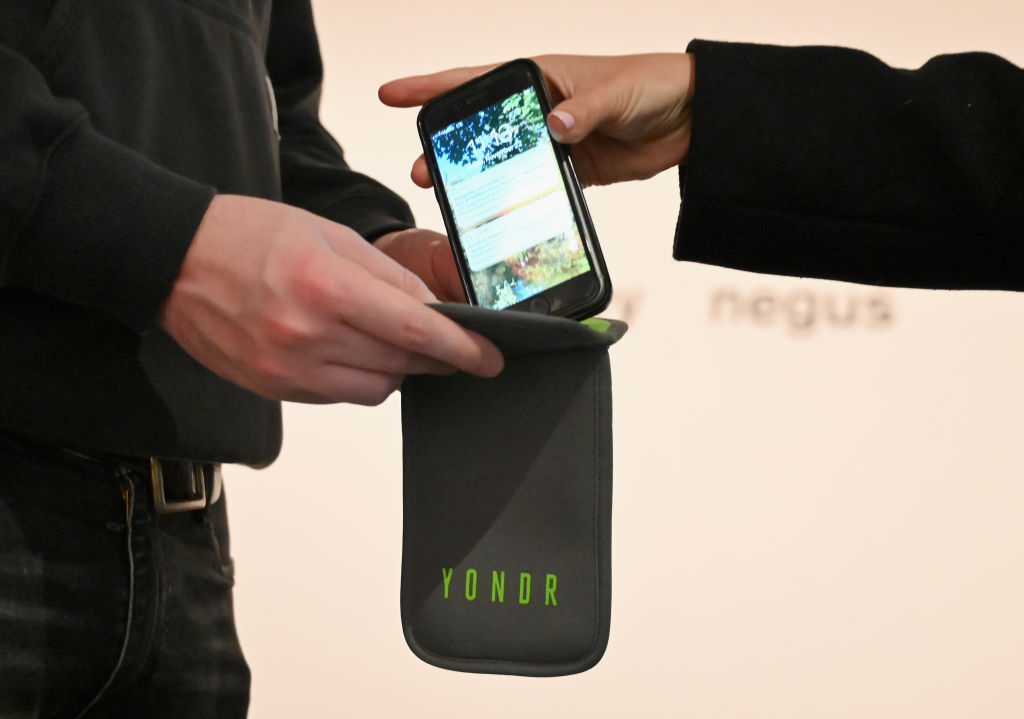
W hen the students at Eastlake High School in Colorado Springs, Colo., returned to their school building in January 2021 following the COVID-19 lockdowns, principal Cassandra Berry noticed that they were glued to their phones even more than before. Students texted throughout classes, ignoring teachers. Fights broke out, sparked by nasty missives sent over DMs and posted on social media.
“We had a couple of fights, and unfortunately, one of them was taped by a student in the classroom and posted on social media,” Berry says. “We wanted to make sure to nip that in the bud.”
After mulling different solutions, Berry signed a contract this year with Yondr, an ed-tech company that sells locked pouches for cell phones. Berry learned about them when she went to a Dave Chappelle comedy show that required audience members to stow their phones during the performance. She liked the experience and thought it could be effective for her students as well.
Eastlake High School now is one of thousands of schools across the world that have turned to Yondr in order to combat phone addiction and distraction. Founded in 2014, Yondr has rapidly expanded since the pandemic and now serves more than 1 million students in 21 countries. The company has had more than a tenfold increase in sales from government contracts since 2021, from $174,000 to $2.13 million, according to GovSpend , a data service.
Some teachers swear by Yondr, saying it has dramatically transformed their classrooms to allow students to actually focus on learning. But many students have decried it as invasive and paternalistic, and some parents argue that phones are a safety tool, especially given the proliferation of school shootings. Some experts also worry that the money spent on Yondr could be better spent on other resources.
“I would call into question if you’re putting it into schools that are quote-unquote under-resourced academically,” says Tanji Reed Marshall, CEO and principal consultant of Liaison Educational Partners. ‘“So you don't want to support my academics, but you want to put my money on buying a tool to keep me off my phone?’”
The debate over whether phones belong in schools has raged for more than a decade. A 2015 study found that test scores rose by as much as 6% after cell phone bans were enacted. Phone usage has only escalated since then: A Pew Research Center study last year found that a third of teens were on social media “almost constantly.”
A majority of parents support limits on cell phone usage in schools, one study found, and many schools already have cell phone bans in place. But the same study found that parents are largely skeptical of taking phones away from kids outright. And many students have tried to resist these more restrictive measures. At least 80 petitions calling for schools to stop using Yondr have been created on Change.org. “They are inconvenient and a waste of money,” reads one petition started in January 2023, which has garnered over 600 signatures.
Nevertheless, some U.S. school districts, including in Holyoke, Mass., and Akron, Ohio , have mandated it for middle and high school students, and legislative efforts may be coming as well: Both Republican and Democratic Senators have flagged tamping down cell phone use as a priority this congressional year. Arkansas Republican Tom Cotton told CBS News , "Teachers dislike cell phones the way the devil hates holy water."
A Yondr spokesperson addressed student concerns in an email, writing, “There will always be students who try to push boundaries, but in our experience, we see 90/95% compliance in the vast majority of our schools, practically overnight….Yondr is not a punishment, we know that when students are given the opportunity to experience a phone-free school environment, they feel the benefits and can then fully understand why it's a good idea to have regular breaks from their phones/social media.” The spokesperson added that the company’s reach in schools is expected to “grow significantly” for the next academic year.
At the start of every day at Eastlake High School, students turn off their phones and put them in individual Yondr pouches. They keep their ensconced phones on them and then unlock them by tapping them on a magnetic device at the end of each day as they leave. After more than a month of Yondr usage, Berry says the experiment is helping students focus. “We had a young lady who half the time she's engaged and half the time she's not. After we started doing Yondr, one day she told the teacher, ‘Well, I guess I gotta do classwork, because I don’t have anything else to do,’” Berry says.
Berry says the number of fights between students has decreased, because there are fewer impetuses to start them. “They don't have to worry about what someone's saying about them or what someone thinks about them, because they don’t see it throughout the day,” Berry says. “They're all working on their work.”
Yondr typically costs $25 to $30 a student. Berry says that Eastlake High School used Title IV funds to pay about $2,400 for 80 pouches. She acknowledges that Eastlake’s small size—fewer than 100 kids—allowed them to keep the costs down.
One public school teacher in New South Wales in Australia, who was contacted by TIME via Reddit direct message, has also been very happy with Yondr since their school district implemented it two years ago. “We know that a number of students don't use them correctly and still have their phones accessible, but they're rarely being brought out and used in class or during breaks, which was a significant problem before,” the teacher wrote. “I'm not paranoid about students filming or photographing me during class to then post on social media and rant about me. We've also noticed that our students are far more active and social during their breaks.” (The teacher, who teaches 12- to 18-year-olds, asked TIME not to use their name because they were not authorized to speak about school policies.)
But Yondr’s rollout has been far from perfect. Marshall consulted for a large public school in Massachusetts that tried to introduce it last fall. For a while, the effort was successful: “The administration found that the building didn't have as much high energy, because their weekend drama isn't coming to school with all the texting,” Marshall says.
Within weeks, however, students began to fight back against the program, which they perceived as a control mechanism—especially because the other two schools that shared the same building did not require the pouches. “The students felt put upon. They didn't feel as though they were part of the process and felt this was targeted towards Black and brown kids in schools that are under-resourced,” she says.
And once students started to rebel, they found ways to get to their phones in spite of the pouch. “Students were very adept at adapting to this new environment,” Marshall says. “They found ways to keep phones and pretend they had Yondr. They found ways to break into the Yondr; they found ways to ignore it altogether.” Within 60 days, Marshall says the teachers at the school stopped enforcing the use of Yondr.
Similarly, Regina Galinski, a New York City parent, says that her child’s school’s use of Yondr has been relatively ineffective. “It’s pretty useless, since kids have access to Chromebooks and just chat that way,” she wrote over Facebook Messenger. “It helps in the lower grades when kids follow rules, but as they get older, they are pointless. If you hit the pouch hard enough, it pops open.”
“The pouch is very durable,” a Yondr spokesperson said, “and schools are provided with guidance and processes in which they can ensure students are compliant.”
Improving schools via technology and other novel solutions has proved challenging. A February 2024 report examined a $1.4 billion Department of Education initiative to develop and test new ideas in the classroom and found that only a quarter of those innovations yielded any positive benefits for students and no negative harms.
Marshall says she’s not against Yondr but believes it needs to be rolled out in a conscientious way, and with the buy-in of everyone involved: students, parents, and teachers. “Yondr is neither good nor bad,” Marshall says. “It’s as good or bad as the systems and the conditions around which it is meant to operate.”
More Must-Reads From TIME
- Jane Fonda Champions Climate Action for Every Generation
- Biden’s Campaign Is In Trouble. Will the Turnaround Plan Work?
- Why We're Spending So Much Money Now
- The Financial Influencers Women Actually Want to Listen To
- Breaker Sunny Choi Is Heading to Paris
- Why TV Can’t Stop Making Silly Shows About Lady Journalists
- The Case for Wearing Shoes in the House
- Want Weekly Recs on What to Watch, Read, and More? Sign Up for Worth Your Time
Contact us at [email protected]
You May Also Like
Parental Rights
Parents Don't Want Schools to Confiscate Kids' Phones
A new survey highlights how fear-based parenting drives phone-based childhoods..
Elizabeth Nolan Brown | 3.27.2024 11:30 AM
A majority of American parents want kids to have access to their phones at school, a new survey finds . In addition, most parents think cellphones have a positive effect on their kids' lives.
Debates over teens and smartphones often contain the (assumed or explicit) premise that parents want their kids to stop living what author and social psychologist Jonathan Haidt calls a "phone-based childhood." Popular wisdom today says parents think phones are negatively impacting their childrens' lives and want kids to have less access to phones but feel powerless to change the situation—a premise baked into Haidt's new book, The Anxious Generation: How the Great Rewiring of Childhood Is Causing an Epidemic of Mental Illness (read my review here ).
But a survey conducted earlier this month by the National Parents Union challenges this narrative.
Want more on sex, technology, bodily autonomy, law, and online culture? Subscribe to Sex & Tech from Reason and Elizabeth Nolan Brown.
Phones—the Perfect Vehicle for Helicopter Parenting
In The Anxious Generation , Haidt looks at the rise of various problems among young people and pinpoints two interlocking culprits: the ascendancy of a "phone-based childhood" and the decline of a "play-based childhood." Many folks see this as a simple one-way flow: phones came along and simply wiped out time or motivation for other pursuits. Haidt suggests a somewhat different sequence of events. As parents began to fear everything in the offline world (and instill this fear into their children), individual families and American society more broadly started denying children independence, autonomy, and unstructured free time. "Screen time" started to fill a void that parents, politicians, police, and our culture as a whole had already created.
The new National Parents Union survey perfectly illustrates the way fear-based parenting is driving phone-based childhoods.
In the survey—conducted in February among 1,506 parents of public school students grades K-12—66 percent of parents said their kids have a cell phone and most of these kids (79 percent) take their phones to school. Asked why parents' wanted this, the most common answers were so that kids could "use their phone if there is an emergency" (79 percent agreed) and so parents could get in touch with their children "or find out where they are when needed" (71 percent). Forty percent said it was important for communicating with kids "about their mental health or other needs during the day."
In other words, a lot of parents want their kids to have phones at school because these parents are anxious, afraid, and/or overzealously policing their progeny's whereabouts and feelings.
Hat tip to Bonnie Kristian for first identifying this paradox. "It is increasingly fashionable to talk about the risk phones pose to American kids, especially teenage girls," writes Kristian on Substack:
The dysfunction of the phone-based childhood has become impossible to ignore, thanks in no small part to Haidt's own work. We're all saying it: Make the kids put down their phones at dinner! Ban phones in school! Kick teenagers off social media or confine them to flip phones or take the phones away altogether! But then there's the second level: When push comes to shove, whatever ideals they may spout about rejecting the phone-based childhood, average American parents want their middle and high schoolers to have phones, preferably smartphones with location tracking kept on their persons at all times.
Hey, Teachers, Leave Those Phones Alone
It seems parents are as attached to their kids having phones as their kids are. In light of this, it's unsurprising that many parents frown on policies that totally deny kids access to phones at school (even though the popular/political narrative around kids and phones suggests this is what parents want).
Fifty-six percent of the people surveyed by the National Parents Union said "students should sometimes be allowed to use their cell phones" in school, while just 32 percent said "students should be banned from using their cell phones, unless they have a medical condition or disability for which they need to use a cell phone."
Even among the group who said most students should be banned from using phones, only 30 percent wanted this ban to apply broadly (i.e., outside of class). Most said phones should be banned during academic instruction but allowed at other times, such as during lunch or recess or during periods between classes.
In keeping with this, relatively few of the parents surveyed supported school policies that keep kids' entirely away from their phones during the day.
Fifteen percent said schools should "require students to place their cell phones in a central location in their classroom, such as a cubby or holder, but don't lock them up" and 14 percent said they should "require students to place their cell phones in a locked cabinet or cell phone lockers in their classroom." Another 8 percent said schools should "lock up students' cell phones in secure pouches or containers that they can carry with them but that prevent them from using their phone."
The most popular answer—shared by 59 percent of the parents surveyed—was that schools should "allow students to keep their phones in their backpack or bag (not locked up) as long as they don't take them out and keep them on silent."
Reassuringly, very few people (5 percent) think the federal government should make decisions about school phone policies and only 10 percent say it should be a state-level government decision.
Most parents think phone policies should be made at the school district level (29 percent), the school level (28 percent), or at the classroom level (18 percent).
The Upsides of Screen Time
Some of the data in this survey fits popular narratives about kids and phones, like the ideas that they're starting young and spending a lot of time on them.
Among parents who allowed their children to have cellphones, the most popular ages to have given phones to them was between 10 and 13 years old. (The survey does not say what type of phones were given, so it's possible many kids received dumb phones to start.) Only 13 percent of parents waited until a kid was age 14 or older.
Among those whose kids had cell phones, only 18 percent estimated that their child spends less than 2 hours per day on it. Some 28 percent estimated that their kid spends between 2 and 3 hours per day on their phones, with 29 percent suggesting their kid uses it for 4 or 5 hours per day, 12 percent saying 6 or 7 hours per day, and 9 percent saying their kids are on phones for upwards of 8 hours per day.
And yet, most parents seem pretty unalarmed by this phone usage. Just 9 percent said phones had a mostly or entirely negative effect on their kids.
Nearly half—46 percent—said the phone had a mostly or entirely positive effect on their child, while 42 percent said the effect was "about equally positive and negative."
This stands out as at odds with what we commonly hear in the media and from legislators about how parents view kids' phone use. But it's in keeping with what many kids themselves say. In a 2022 survey of American 13- to 17-year-olds, conducted Pew Research Center, kids identified all sorts of plus sides to social media (which is, of course, one of the main things that kids use phones for). And a majority—59 percent—said social media is neither a negative nor a positive in their lives, while 32 percent said it's mostly positive and just 9 percent said it's mostly negative.
It's also in keeping with some earlier research on phone adoption among kids. For instance, a 2022 study from Stanford Medicine researchers followed 250 tweens and teens for five years during which most got a first cellphone, tracking study participants' well-being during this transition. The kids were 7 to 11 years old when the study started and 11 to 15 years old when it ended. The researchers "found that whether or not the children in the study had a mobile phone, and when they had their first mobile phone, did not seem to have meaningful links to their well-being and adjustment outcomes," according to lead author Xiaoran Sun.
More Sex & Tech
• Florida Gov. Ron DeSantis signed a law restricting teen use of social media platforms. Under the new law, 14- and 15-year-olds can old start social media accounts with their parents' permission. "This law puts all users' privacy at risk by mandating age verification," said Competitive Enterprise Institute's director of the Center for Technology & Innovation, Jessica Melugin. It also "ignores parents' rightful role in deciding what is and is not appropriate for their child, and may sacrifice too much of the free flow of speech to be constitutional. It's political click bait, but it's not good public policy."
• California lawmakers are considering a bill that would require large online platforms to verify the identities of "influential" users. Influential here is defined to include basically any user that's been at it for a while (that is, if content they've shared "has been seen by more than 25,000 users over the lifetime of the accounts that they control or administer").
• Mother Jones has an interesting interview with Lynn Paltrow , founder of the National Advocates for Pregnant Women (now called Pregnancy Justice). "For much of the past 50 years, the mainstream pro-choice groups were focused almost exclusively on the right to abortion," said Paltrow, who believes this was a mistake. "There was no campaign to explain abortion as necessary to the full equality and citizenship—the personhood—of women in this country. They were defending abortion as opposed to the people who sometimes need abortions but always need to be treated as full constitutional persons under the law, whatever the outcome of their pregnancies."
Today's Image

California Won't Let Homeowners Insurance Companies Raise Rates, so They're Leaving the State Instead
Steven Greenhut | 3.29.2024 7:30 AM
Minimum Wage Laws Make for Great Politics, but Fewer Jobs
J.D. Tuccille | 3.29.2024 7:00 AM
Review: Violation Podcast Dissects the Broken U.S. Parole System
Billy Binion | From the April 2024 issue
Review: Musical Movie Doesn't Recapture Mean Girls ' Genuine Meanness
Katherine Mangu-Ward | From the April 2024 issue
Brickbat: Science Doesn't Lie, but Scientists Do
Charles Oliver | 3.29.2024 4:00 AM
New Florida Law Aims to Get Kids Off Social Media. Will It Work?

- Share article
Florida will have one of the country’s most restrictive social media bans for minors under a bill signed by Gov. Ron DeSantis on March 25.
The law , which will take effect on Jan. 1, prohibits social media platforms from allowing children younger than 14 to have an account. For 14- and 15-year-olds, social media platforms must require parental permission before allowing them to set up accounts.
Addressing adolescents’ worsening mental health recently has become a top priority for school, district, state, and federal leaders as young people struggle with record-high rates of depression and anxiety .
Much of the conversation around the mental health crisis has focused on young people’s constant use of cellphones and social media. Some states, including Florida, already ban or are considering banning cellphones in classrooms . More than 200 districts have sued major social media companies over the youth mental health crisis.
“We dug into the research showing the negative effects of social media on children, and it directly pointed to the addictive features these companies develop to keep our kids hooked,” Florida House Speaker Paul Renner said in an email statement to Education Week.
Florida’s social media ban doesn’t target specific platforms. Instead, the bill says that the law applies to any platform where at least 10 percent of daily active users are children younger than 16 who use it for two hours or more a day; that uses “addictive” features, such as infinite scrolling; and that uses algorithms that analyze user data to handpick content for users.
Most social media platforms already state in their policies that children younger than 13 aren’t allowed to create accounts. But the law requires these platforms to actually verify the age of its users. It leaves it up to the companies to determine how to meet the requirements. If a social media platform is found in violation, the state Department of Legal Affairs may fine the platform up to $50,000 per violation. Parents or caregivers could also file lawsuits against the platforms.

Similar bans in other states have run into legal issues
Arkansas, California, Ohio, and Utah passed similar bans last year on kids using social media , but none of those laws has taken effect yet because of legal issues. Federal judges have stopped the legislation from taking effect over concerns that the bans violate kids’ free speech rights and that age verifications are unconstitutional.
Renner said during the bill signing that he expects social media companies to file lawsuits, but he’s confident the state will beat them, the Associated Press reported .
Carl Szabo, the vice president and general counsel for NetChoice, called the law “unconstitutional,” because it “infringes on Floridians’ First Amendment rights,” in an email statement to Education Week.
It’s “bad policy because of the data collection on Floridians by online services it will in effect require. This will put their private data at risk of breach,” Szabo added.
NetChoice is a trade association of online businesses that advocate free expression and free enterprise on the internet. It includes TikTok, Meta (the parent company of Instagram and Facebook), and Snap (the parent company of Snapchat). The organization has filed lawsuits against similar legislation in Arkansas, California, and Utah.
The Florida law has a contingency plan to put in motion if a court decides to prohibit the enforcement of the section that requires parental consent for 14- and 15-year-olds to use social media. It says in that case, the law will just prohibit anyone 15 years old or younger from using social media.
“It almost seems like they [the state] were preemptively punishing [anyone who tries to file a lawsuit], saying ‘All right, if you won’t give us this, we’re going to be even stricter,’” said Amelia Vance, the president of the Public Interest Privacy Center, which advocates effective, ethical, and equitable privacy safeguards for all children and students.

‘We just don’t know’ if bans work
Vance is skeptical that Florida’s ban will make children safer online. Kids will find ways around these restrictions if they really want to be on those platforms, she said.
“The approach that is most likely going to be effective here is the one that says, ‘OK, kids are going to be online. Let’s give them special protections when they are,” Vance said. The state’s “Digital Bill of Rights,” which passed last year and takes effect in July, would probably be more effective because it puts in place protections around what data can be collected and places limits around how the data can be used, she said.
Kris Perry, the executive director of Children and Screens, a nonprofit organization that seeks to understand and address the implications of digital media on child development, said a ban “will protect kids from the harms related to social media,” but it will also prevent them from “accessing the benefits.”
“It’d be really important to study whether or not the ban accomplished its intended goal,” Perry said. “We just don’t know, without studying the aftereffects of whether that was an effective strategy.”
In Florida, the statewide ban on students using cellphones during instructional time that went into effect last year has had a positive impact in some schools on student behavior and learning, according to Renner.
“We are hopeful that steering kids toward the real world and away from a warped digital world will result in even more positive outcomes [for student learning],” Renner said in the statement to Education Week.

Equipping students with the right skills
For students, the focus shouldn’t be on restriction, said Ava Havidic , 18, a senior at Millennium 6-12 Collegiate Academy in Broward County, Fla.
“When you ban things or when you restrict things, sometimes, it’s going to be like a green light for students to say, ‘OK, how can I override that? How can I find my way to use it still?’” said Ava, who serves as a student adviser for the Broward County school board.
The focus should instead be on “explaining why it’s important to limit usage” and “formulating a mindset at a young age so they can learn how to use it correctly,” she said.
Kids will become adults, and they’re going to be using these platforms, and if we limit their use and don’t teach them the right way to use it, “they’re not going to be prepared,” she added.
Sign Up for The Savvy Principal
Edweek top school jobs.

Sign Up & Sign In


IMAGES
COMMENTS
Phones should be allowed in class because it allows students to exercise self-discipline no matter their age or activity, which is proved by a study by the University of Pennsylvania, that self-discipline plays a big part in a student's success. Also, them having the freedom of their phone usage allows them to learn how to deal with freedom ...
Bans may help protect classroom focus, but districts need to stay mindful of students' sense of connection, experts say. Students around the world are being separated from their phones. In 2020, the National Center for Education Statistics reported that 77 percent of U.S. schools had moved to prohibit cellphones for nonacademic purposes.
The dramatic rise in cell phone usage globally, including among younger, school-aged users, brings into focus the debate on why phones should be allowed in school.. Cell phones are a forbidden item in most classrooms. Many schools have policies against students taking their gadgets out of their backpacks during the day or even bringing them to school at all.
The role of cell phones and other screen technologies in classrooms continues to generate much dis-cussion and heated debate in Canada, the U.S., and beyond. More specifically, how to best manage the increasing ubiquity of cell phones in schools continues to challenge teachers, pedagogical leaders, ad-ministrators, and policymakers alike.
In conclusion, cell phones should not be banned from schools because they are used for academic purposes. They provide quick access to knowledge, and they are learning in a method that is comfortable for them, and they can maintain in touch with their parents. In the end mobile devices have their benefits.
Most research around cellphone use in schools looks at the impact on test scores, reaction time, and the ability to focus. You look instead at two areas: discipline and a sense of safety. The existing studies provide evidence that allowing phones in the classroom negatively impacts test scores and long-term learning retention.
Cell phones provide an immediate connection to parents and emergency services, enabling quick responses and potentially saving lives. Beyond emergencies, cell phones play a crucial role in addressing safety concerns within schools. Students can discreetly report incidents of bullying, harassment, or other safety issues to school authorities ...
This essay presents an argumentative perspective on why cell phones should be allowed in schools, highlighting their potential benefits in enhancing learning, communication, and preparedness for the digital age.
Cellphones are both a powerful learning tool and huge distractions for kids. Figuring out how to make the most of them is "really tricky," said Taylor, a fan of technology in the classroom who ...
Both are fairly avoidable, but it doesn't mean phones should be banned (paper wasn't!). We believe the focus of smartphone use in the classroom should shift from not if they should be used, but how to best use them. While critics will cite the opportunity for cheating, unauthorized socializing, and social isolation issues involved, the fact ...
Cell phones and smartphones are a big part of modern life. Many people use them every day, including kids and teens. But there's still a debate about cell phones in school. In this guide, we'll look at some arguments for why should phones be allowed in school, while also addressing some common concerns parents may have. Contents:
Initially, the school required students to keep their phones off and put away during the school day. Phones could be confiscated if students were found using them. This is common policy, but Frey and Fisher write that it created a lot of frustration. Teachers and administrators weren't happy with the amount of time they had to spend enforcing ...
Conclusion. In conclusion, cell phones should be allowed in school, especially for students in grades 10, 11 and 12, because they can be used for school work and are a cheaper alternative for laptops. Banning cell phones for students will not stop them using them.
Starting in September 2019, cell phones will be banned in Ontario classrooms during instructional time. The new ban means elementary and secondary school students won't be able to use their cellphones in the classroom unless it is for educational purposes, medical reasons, or as a support for students with special needs.
There are 12 comments on Why Schools Should Ban Cell Phones in the Classroom—and Why Parents Have to Help. saydi. ... this helped me with my essay! thank you! Reply. Link Mazie Ofrane. March 14, 2024 at 12:17 pm I don't think phones should be allowed in school, and this is perfect backup! Thank you Doug. Reply. Link evelyn. March 18, 2024 ...
But, overall, educators are divided on the issue. "We should be learning to manage cellphones in the classroom. They are here to stay," one educator said in the survey. "BUT they are the ...
The rationale against cellphones in schools is that excessive exposure to the devices will have a negative effect on school-aged kids - lowering grades, promoting cyberbullying and even ...
List of the Pros of Allowing Cellphones in Schools. 1. It offers parents and students an extra layer of security. In the United States, school violence is an ongoing issue that students face as they get older. In an investigation by The Washington Post, U.S. students have endured an average of 10 school shootings per year since the events that ...
Most cell phones have a built-in dictionary. All it takes is a few taps (or a question to Siri) to learn what new words mean, how they're used in a sentence, and if they have any synonyms. Phones help kids learn how to organize. In the twenty-first century, phones are the key to coordination.
First, let's talk about why students might be allowed to use their cellphones in school. One big reason is for safety. With a cellphone, students can quickly call for help in an emergency. Another reason is that cellphones can be used for learning. Many phones have apps for studying, and students can use them to look up information or ...
87. Cellphones taken from students are kept in a phone safe at Timber Creek High School in Orlando, Fla. Zack Wittman for The New York Times. By The Learning Network. Nov. 30, 2023. Nearly one in ...
Cellphones taken from students are kept in a phone safe at Timber Creek High School in Orlando, Fla. Zack Wittman for The New York Times. By Jeremy Engle. Nov. 7, 2023. Nearly one in four ...
Reasons Why Cell Phones Should Be Allowed In School. It gives many parents comfort and reassurance. Being able to reach their kids during their free time is important for moms and dads, who are worried about the potential dangers of kidnapping and violence even in relatively safe areas. It allows for the use of technology as a learning tool.
The debate over whether phones belong in schools has raged for more than a decade. A 2015 study found that test scores rose by as much as 6% after cell phone bans were enacted. Phone usage has ...
Fifty-six percent of the people surveyed by the National Parents Union said "students should sometimes be allowed to use their cell phones" in school, while just 32 percent said "students should ...
The law , which will take effect on Jan. 1, prohibits social media platforms from allowing children younger than 14 to have an account. For 14- and 15-year-olds, social media platforms must ...
Essay Available: 15% First Time Discount. Fill out our order form with detailed instructions and give us some time for writing magic. Get Custom Essay from: 12.93$. Order now.
Essay Available: 15% First Time Discount. Fill out our order form with detailed instructions and give us some time for writing magic. Get Custom Essay from: 12.93$. Order now.